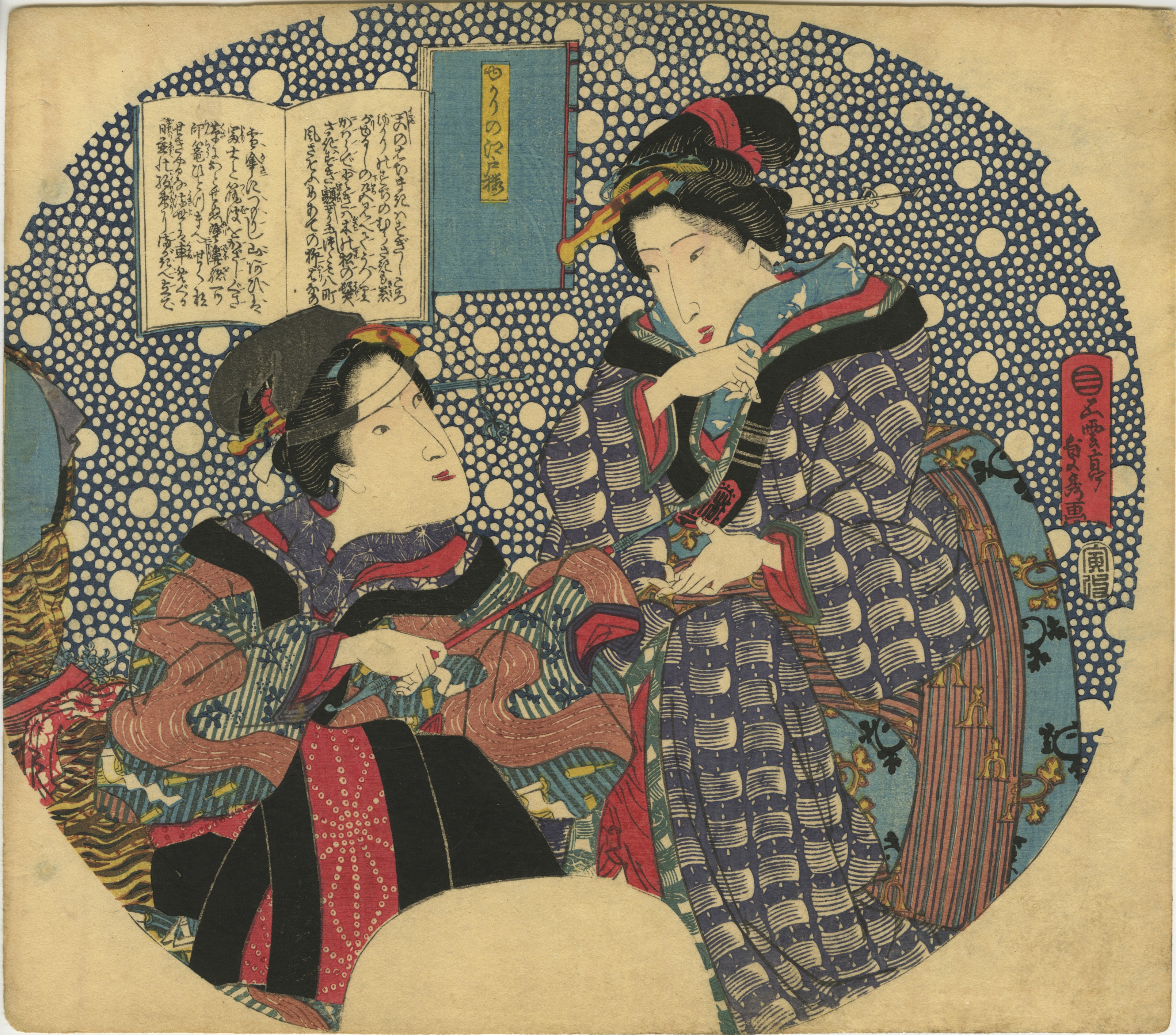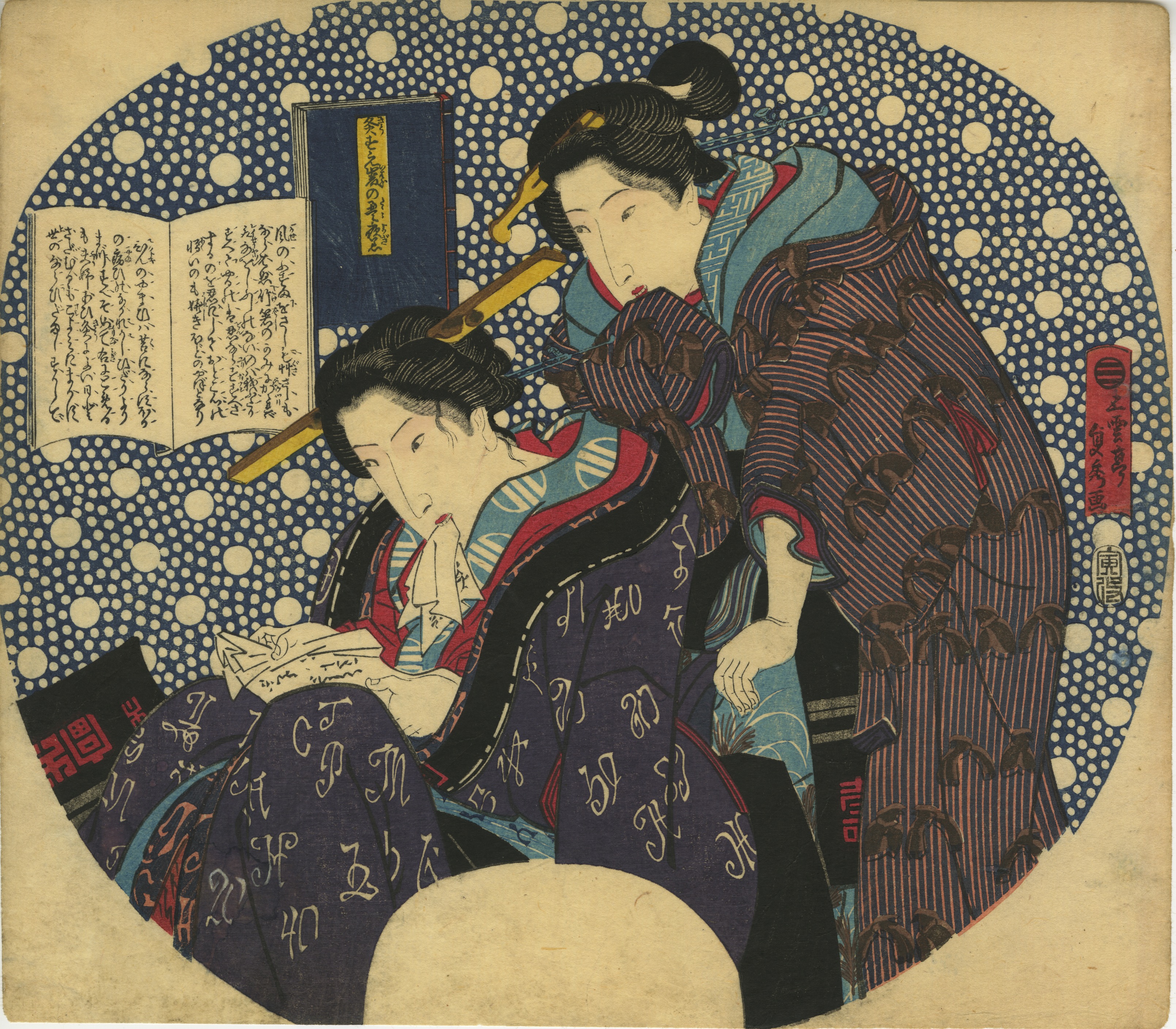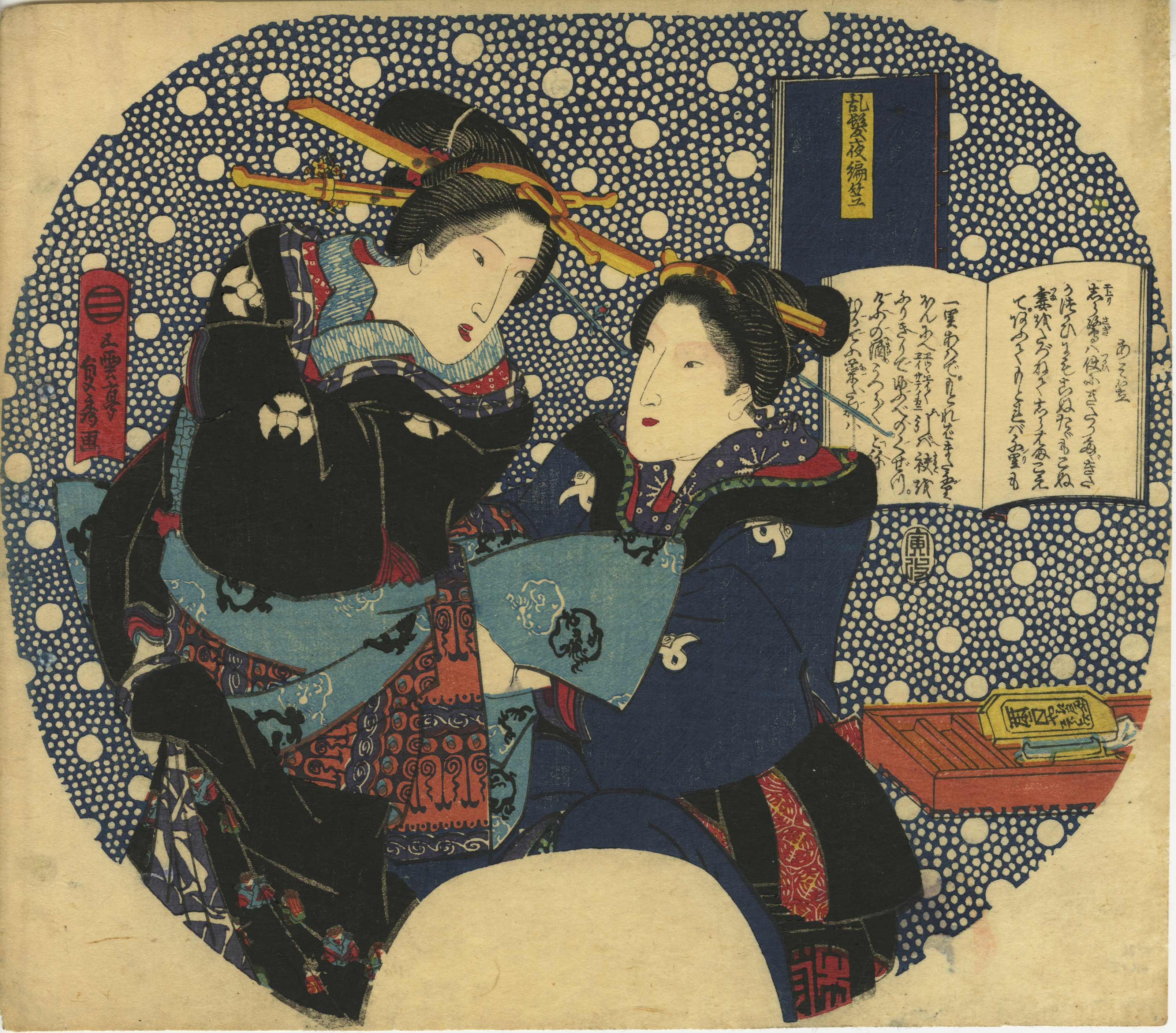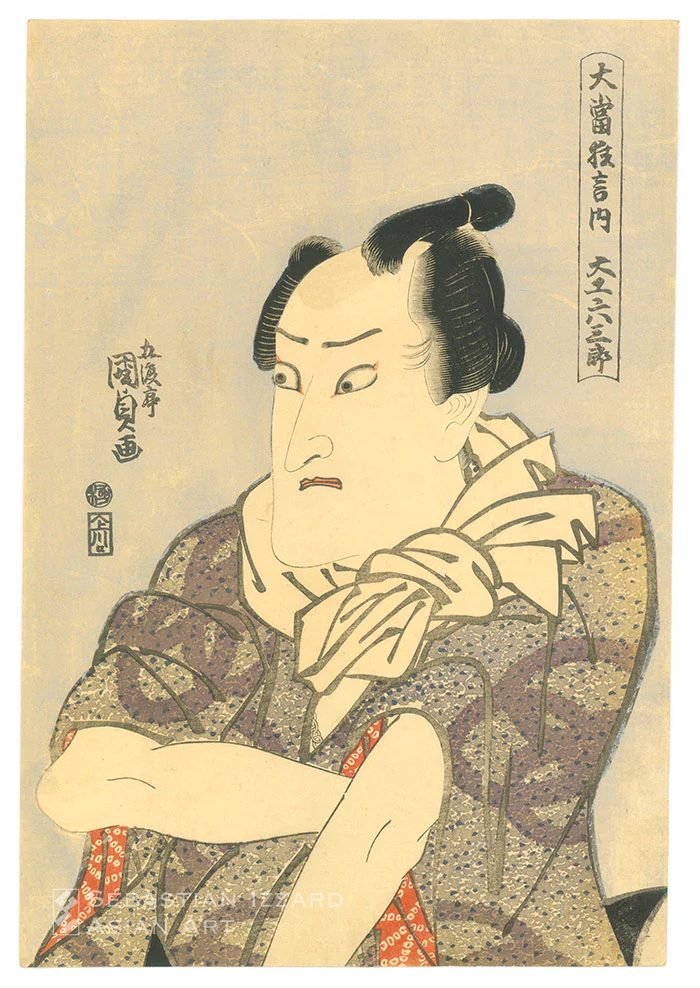-
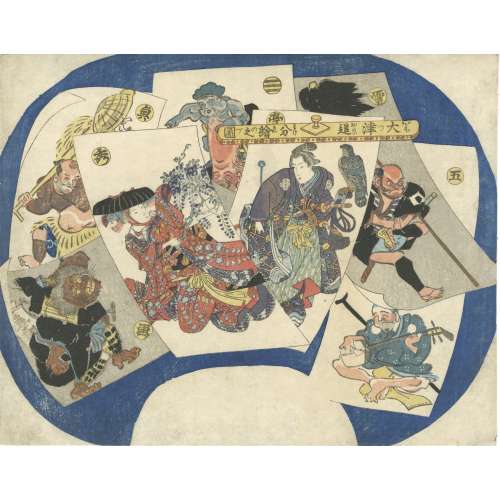 An uncut fan print showing Otsu-e [大津絵] (Otsu pictures). Artist: Utagawa Sadahide [歌川貞秀] (Japanese, 1807 – 1879). Signed: Gountei Sadahide ga [五雲亭貞秀画] (Picture by Gountei Sadahide); characters on the Otsu-e. Publisher: Ibaya Senzaburō [伊場屋仙三郎] (Japanese, c. 1815 – 1869). Published: c. 1849. Inscription in a paper-weight shaped cartouche: [大津追 分絵の図] Ōtsu-oi wake-e no zu (Following Otsu – image of separate pictures) No date seal, no censor seal (privately printed?) Media: Fan print (uchiwa-e, 団扇絵), 235 x 298 mm.
An uncut fan print showing Otsu-e [大津絵] (Otsu pictures). Artist: Utagawa Sadahide [歌川貞秀] (Japanese, 1807 – 1879). Signed: Gountei Sadahide ga [五雲亭貞秀画] (Picture by Gountei Sadahide); characters on the Otsu-e. Publisher: Ibaya Senzaburō [伊場屋仙三郎] (Japanese, c. 1815 – 1869). Published: c. 1849. Inscription in a paper-weight shaped cartouche: [大津追 分絵の図] Ōtsu-oi wake-e no zu (Following Otsu – image of separate pictures) No date seal, no censor seal (privately printed?) Media: Fan print (uchiwa-e, 団扇絵), 235 x 298 mm. -
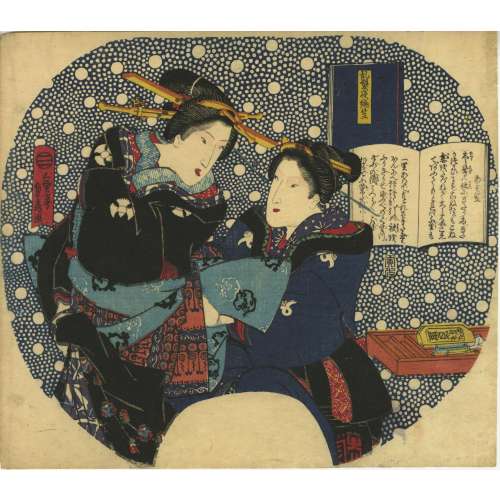 Artist: Utagawa Sadahide [歌川 貞秀], a.k.a. Gountei Sadahide [五雲亭 貞秀] (1807 – c. 1878/9). Signed: Gountei Sadahide ga [五雲亭貞秀画] Pubisher: Ibaya Senzaburō [伊場屋仙三郎] (Japanese, 1815 – 1869) Date-aratame seal: Bunsei 13 / Tenpō 1 (1830). Ref: Ritsumeikan University # Z0172-587. Title: Tangled Hair and the Evening Braided Hat [乱髪夜編笠] (Midaregami Yoru no Amigasa). The open book starts with the chapter title that reads Amigasa. This play was performed together with Kisohajime Hatsugai Soga [着衣始]初買曽我]. See the playbill for the performance at Moritaza at MFA (Boston) № 11.27208. 乱髪夜編笠(みだれがみよるのあみがさ。「夜の編笠」「白さぎ」
Artist: Utagawa Sadahide [歌川 貞秀], a.k.a. Gountei Sadahide [五雲亭 貞秀] (1807 – c. 1878/9). Signed: Gountei Sadahide ga [五雲亭貞秀画] Pubisher: Ibaya Senzaburō [伊場屋仙三郎] (Japanese, 1815 – 1869) Date-aratame seal: Bunsei 13 / Tenpō 1 (1830). Ref: Ritsumeikan University # Z0172-587. Title: Tangled Hair and the Evening Braided Hat [乱髪夜編笠] (Midaregami Yoru no Amigasa). The open book starts with the chapter title that reads Amigasa. This play was performed together with Kisohajime Hatsugai Soga [着衣始]初買曽我]. See the playbill for the performance at Moritaza at MFA (Boston) № 11.27208. 乱髪夜編笠(みだれがみよるのあみがさ。「夜の編笠」「白さぎ」とも)– one of the main melodies in katōbushi (河東節) type of jōruri [浄瑠璃]. For a detailed explanation in Japanese, see also HERE). A series of three prints is dedicated to a katōbushi performance of the Soga-themed plays.
They all have a background of hail patterns (Arare-ko-mon) [霰小紋], similar to Kunisada’s Iwai Kumesaburō II as An no Heibei [SVJP-0304.2019], see below.Yukari no Edo-zakura The tatami night robe of Iwao Tangled Hair and the Evening Braided Hat 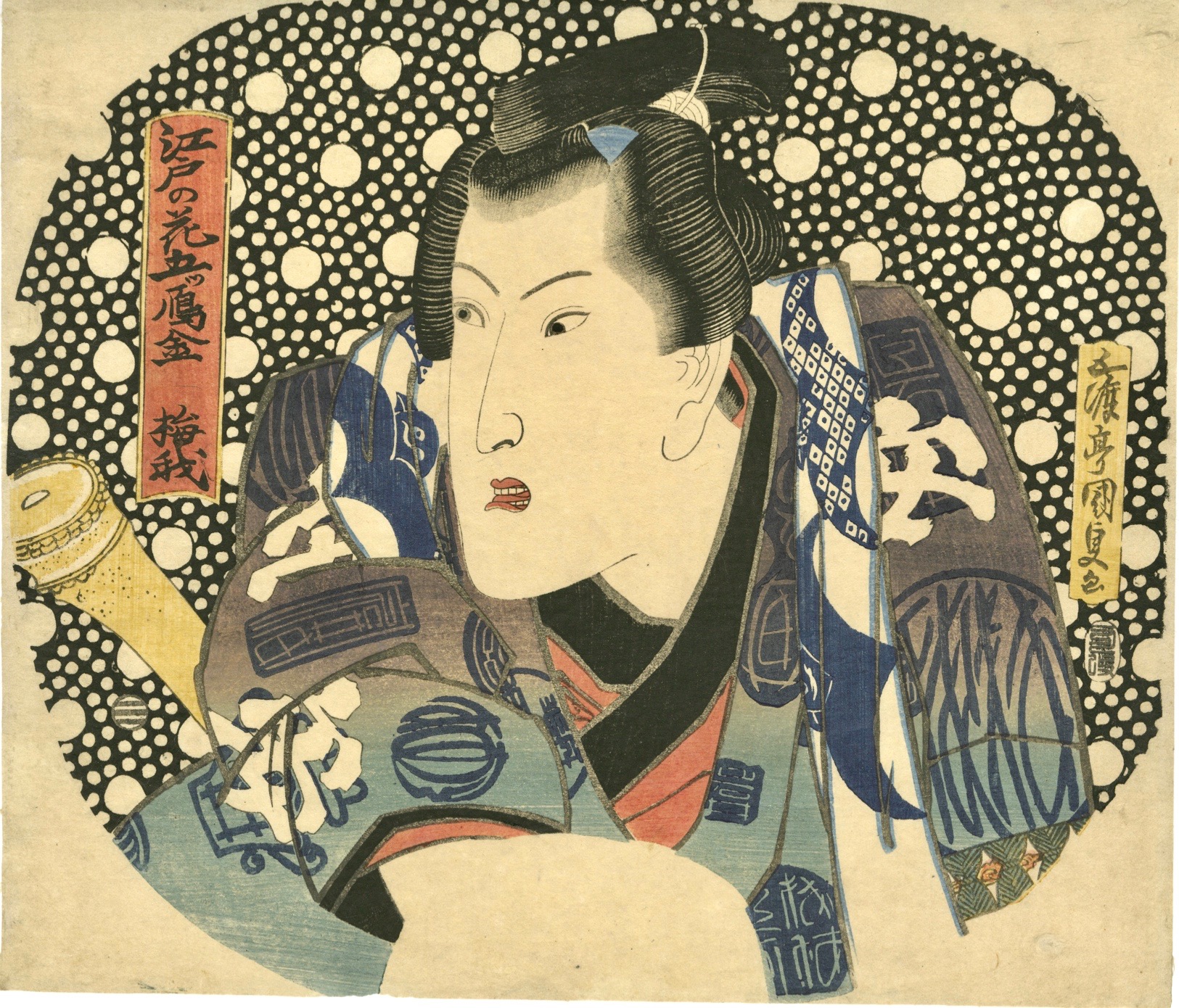
-
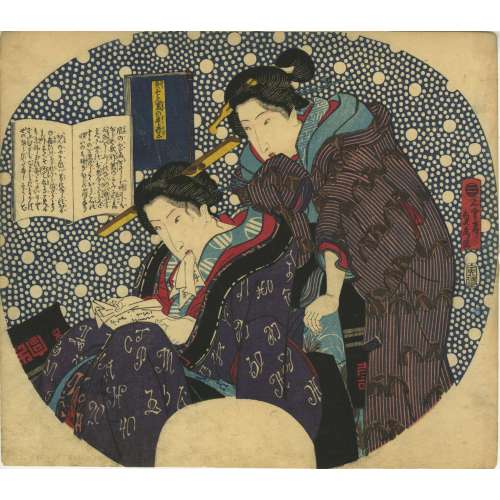 Artist: Utagawa Sadahide [歌川 貞秀], a.k.a. Gountei Sadahide [五雲亭 貞秀] (1807 – c. 1878/9). Signed: Gountei Sadahide ga [五雲亭貞秀画] Pubisher: Ibaya Senzaburō [伊場屋仙三郎] (Japanese, 1815 – 1869) Date-aratame seal: Bunsei 13 / Tenpō 1 (1830). Ref: Ritsumeikan University # Z0172-587. Title: The tatami night robe of Iwao [巌の畳夜着] (Kyusue Iwao no tatami yogi); 灸すゑ巌の畳夜着(きゅうすえいわおのたたみよぎ。「灸すえ」– one of the main melodies in katōbushi (河東節) type of jōruri [浄瑠璃]. For a detailed explanation in Japanese, see also HERE). The night robe of Iwao is decorated with characters resembling Arabic numerals, and Latin and Cyrillic letters. A similar kimono can be seen on Kunisada's print Hotoke Gozen, Mirror of Virtuous and Wise Women (Kenjo Kagami) at RISD museum accession number 13.1383, portraying Hotoke Gozen (佛御前), a character of The Tale of the Heike [平家物語] (Heike Monogatari); published by Yamamotoya Heikichi (山本屋平吉) (Japanese, fl. c. 1812 – 1886) in the 1830s (see below).A series of three prints is dedicated to a katōbushi performance of the Soga-themed plays.
Artist: Utagawa Sadahide [歌川 貞秀], a.k.a. Gountei Sadahide [五雲亭 貞秀] (1807 – c. 1878/9). Signed: Gountei Sadahide ga [五雲亭貞秀画] Pubisher: Ibaya Senzaburō [伊場屋仙三郎] (Japanese, 1815 – 1869) Date-aratame seal: Bunsei 13 / Tenpō 1 (1830). Ref: Ritsumeikan University # Z0172-587. Title: The tatami night robe of Iwao [巌の畳夜着] (Kyusue Iwao no tatami yogi); 灸すゑ巌の畳夜着(きゅうすえいわおのたたみよぎ。「灸すえ」– one of the main melodies in katōbushi (河東節) type of jōruri [浄瑠璃]. For a detailed explanation in Japanese, see also HERE). The night robe of Iwao is decorated with characters resembling Arabic numerals, and Latin and Cyrillic letters. A similar kimono can be seen on Kunisada's print Hotoke Gozen, Mirror of Virtuous and Wise Women (Kenjo Kagami) at RISD museum accession number 13.1383, portraying Hotoke Gozen (佛御前), a character of The Tale of the Heike [平家物語] (Heike Monogatari); published by Yamamotoya Heikichi (山本屋平吉) (Japanese, fl. c. 1812 – 1886) in the 1830s (see below).A series of three prints is dedicated to a katōbushi performance of the Soga-themed plays.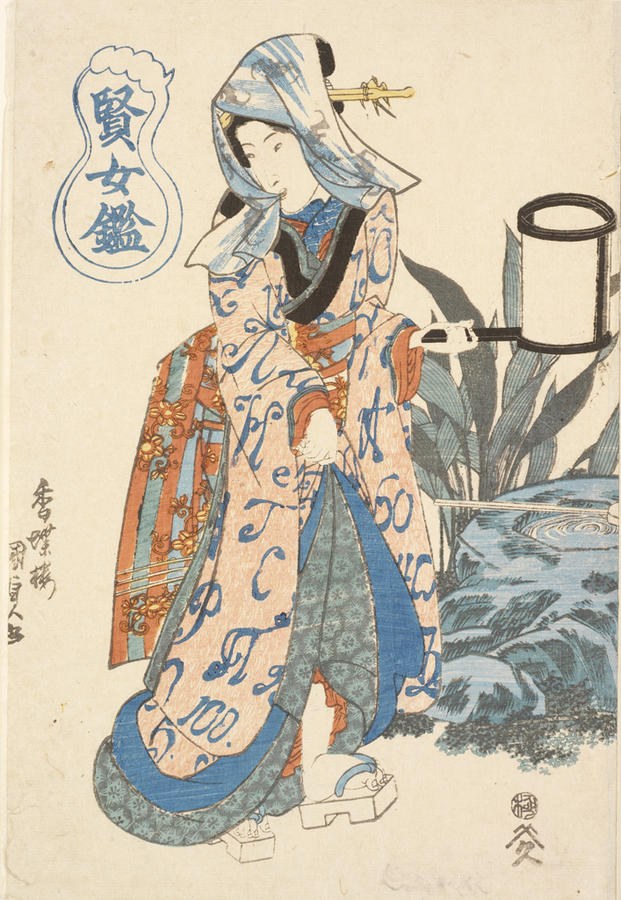
RISDM 13-1383
They all have a background of hail patterns (Arare-ko-mon) [霰小紋], similar to Kunisada’s Iwai Kumesaburō II as An no Heibei [SVJP-0304.2019], see below.Yukari no Edo-zakura The tatami night robe of Iwao Tangled Hair and the Evening Braided Hat 
-
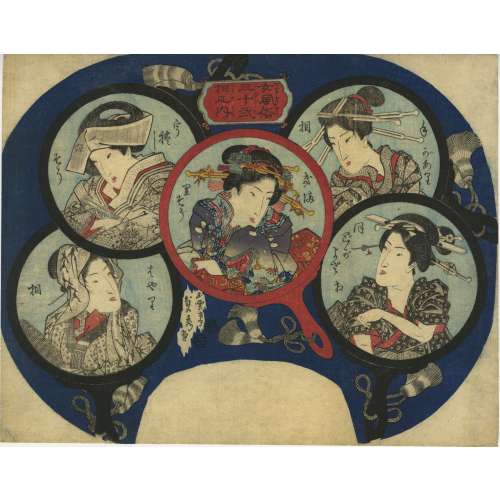 NEWArtist: Utagawa Sadahide [歌川貞秀] (Japanese, 1807 – 1879). Signed: Gountei Sadahide ga [五雲亭貞秀画] (Picture by Gountei Sadahide). Publisher: Ibaya Senzaburō [伊場屋仙三郎] (Japanese, c. 1815 – 1869); seal 三 in a circle Published: 1830s – no date seal, no censor seal (privately printed?) Media: Fan print (uchiwa-e, 団扇絵), 235 x 298 mm Inscriptions in kanji with furigana readings: Top right: "The Handy Type" (手があり相, te ga ari sō) – A composed woman adjusting her clothing. Bottom right: "Images of Manners" (風ぞくが, fūzokuga) – Possibly referring to depictions of etiquette or courtesan behaviour. The additional phrase 宵闇 (yoyami) 相 (sō) suggests a connection to nighttime activities. Centre: "The Proper Type" (きまり相, kimari sō) – A well-dressed woman seated elegantly, signifying a composed demeanour. Top left: Unclear reading (ほう☆し そう or ☆ほし そう) – Possibly related to 奉仕 (hōshi, "service" or "devotion"), implying attentiveness or subservience. Bottom left: "The Popular Type" (はやり相, hayari sō) – A fashionable woman wearing a partially veiled head covering, reflecting contemporary trends. Thanks to Horst Graebner.
NEWArtist: Utagawa Sadahide [歌川貞秀] (Japanese, 1807 – 1879). Signed: Gountei Sadahide ga [五雲亭貞秀画] (Picture by Gountei Sadahide). Publisher: Ibaya Senzaburō [伊場屋仙三郎] (Japanese, c. 1815 – 1869); seal 三 in a circle Published: 1830s – no date seal, no censor seal (privately printed?) Media: Fan print (uchiwa-e, 団扇絵), 235 x 298 mm Inscriptions in kanji with furigana readings: Top right: "The Handy Type" (手があり相, te ga ari sō) – A composed woman adjusting her clothing. Bottom right: "Images of Manners" (風ぞくが, fūzokuga) – Possibly referring to depictions of etiquette or courtesan behaviour. The additional phrase 宵闇 (yoyami) 相 (sō) suggests a connection to nighttime activities. Centre: "The Proper Type" (きまり相, kimari sō) – A well-dressed woman seated elegantly, signifying a composed demeanour. Top left: Unclear reading (ほう☆し そう or ☆ほし そう) – Possibly related to 奉仕 (hōshi, "service" or "devotion"), implying attentiveness or subservience. Bottom left: "The Popular Type" (はやり相, hayari sō) – A fashionable woman wearing a partially veiled head covering, reflecting contemporary trends. Thanks to Horst Graebner. -
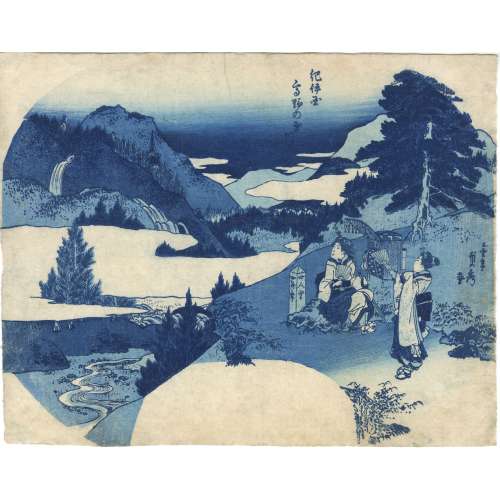 An uncut aizuri fan print showing two travellers admiring the view of the Tama River [多摩川] (Tamagawa) and Mount Kōya [高野山] (Kōyasan) in Kii Province [紀伊国] (Kii no Kuni). Artist: Utagawa Sadahide [歌川貞秀] (Japanese, 1807 – 1879). Signed: Gountei Sadahide ga [五雲亭貞秀画] (Picture by Gountei Sadahide). Publisher: Unknown. Published: c. 1849. No date seal, no censor seal (privately printed?) Media: Fan print [団扇絵] (uchiwa-e), 235 x 300 mm.
An uncut aizuri fan print showing two travellers admiring the view of the Tama River [多摩川] (Tamagawa) and Mount Kōya [高野山] (Kōyasan) in Kii Province [紀伊国] (Kii no Kuni). Artist: Utagawa Sadahide [歌川貞秀] (Japanese, 1807 – 1879). Signed: Gountei Sadahide ga [五雲亭貞秀画] (Picture by Gountei Sadahide). Publisher: Unknown. Published: c. 1849. No date seal, no censor seal (privately printed?) Media: Fan print [団扇絵] (uchiwa-e), 235 x 300 mm. -
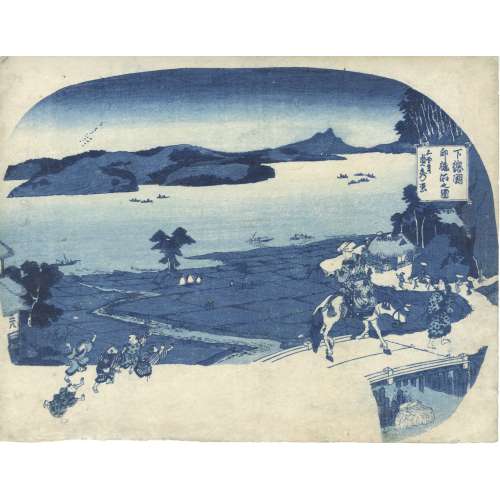 An uncut aizuri fan print showing travellers arriving at Inba Lake [印旛沼] (Inba-numa) on Shimosa Plateau [下総台地] (Shimōsa-daichi). Artist: Utagawa Sadahide [歌川貞秀] (Japanese, 1807 – 1879) Publisher: Unknown. Published: c. 1849. Signed: Gountei Sadahide ga [五雲亭 貞秀画] (Picture by Gountei Sadahide). Inscription in cartouche: Shimosa Plateau, Inbanuma (Inba Lake) [下總國印幡沼]. No date seal, no censor seal (privately printed?) Media: Fan print [団扇絵] (uchiwa-e), 235 x 300 mm.
An uncut aizuri fan print showing travellers arriving at Inba Lake [印旛沼] (Inba-numa) on Shimosa Plateau [下総台地] (Shimōsa-daichi). Artist: Utagawa Sadahide [歌川貞秀] (Japanese, 1807 – 1879) Publisher: Unknown. Published: c. 1849. Signed: Gountei Sadahide ga [五雲亭 貞秀画] (Picture by Gountei Sadahide). Inscription in cartouche: Shimosa Plateau, Inbanuma (Inba Lake) [下總國印幡沼]. No date seal, no censor seal (privately printed?) Media: Fan print [団扇絵] (uchiwa-e), 235 x 300 mm. -
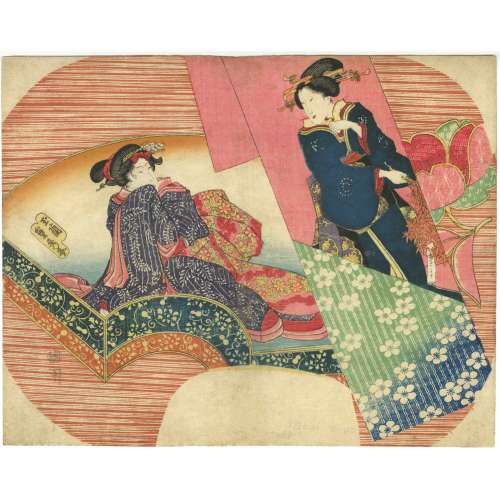 Artist: Utagawa Sadahide [歌川貞秀] (Japanese, 1807 – 1879). Publisher: Kojimaya Jūbei [小島屋重兵衛] (Japanese, c. 1797 – 1869); seal: Marks #264, p. 210) Signed: Gyokuransai Sadahide ga [玉蘭斎貞秀 画]. Date seal: 1830 (Bunsei 13 / Tenpō 1). Size: Uncut fan print (uchiwa-e); 229 x 292 mm
Artist: Utagawa Sadahide [歌川貞秀] (Japanese, 1807 – 1879). Publisher: Kojimaya Jūbei [小島屋重兵衛] (Japanese, c. 1797 – 1869); seal: Marks #264, p. 210) Signed: Gyokuransai Sadahide ga [玉蘭斎貞秀 画]. Date seal: 1830 (Bunsei 13 / Tenpō 1). Size: Uncut fan print (uchiwa-e); 229 x 292 mm -
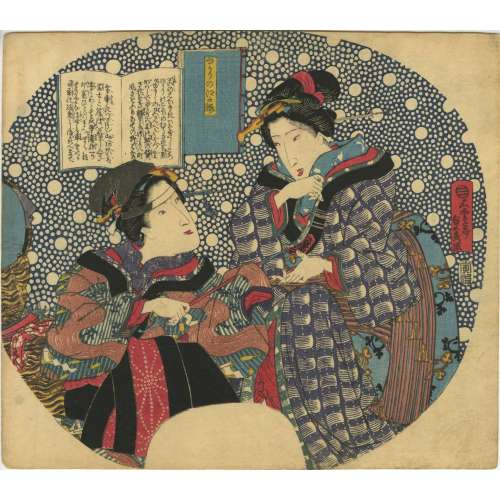 Artist: Utagawa Sadahide [歌川 貞秀], a.k.a. Gountei Sadahide [五雲亭 貞秀] (1807 – c. 1878/9). Signed: Gountei Sadahide ga [五雲亭貞秀画] Pubisher: Ibaya Senzaburō [伊場屋仙三郎] (Japanese, 1815 – 1869) Date-aratame seal: Bunsei 13 / Tenpō 1 (1830). Ref: Ritsumeikan University # Z0172-587. Title: Yukari no Edo-zakura [ゆかりの江戸桜], often translated into English as 'The Flower of Edo', is a one-act kabuki play Sukeroku, written by Tsuuchi Han'emon (fl. 1701 – 1743) under the supervision of Tsuuchi Jihei II (1673 – 1760 ) at the beginning of the 18th century. From the beginning of the 19th century, the play was performed in the style of katōbushi. 助六所縁江戸桜(すけろくゆかりのえどざくら。「助六」– one of the main melodies in katōbushi (河東節) type of jōruri [浄瑠璃]. For a detailed explanation in Japanese, see also HERE). Plot: In search of the stolen Minamoto clan's precious sword called Tomokirimaru, Soga Gorō (historical Soga Tokimune [曾我時致], 1174 – 1193) came to a Yoshiwara brothel under the disguise of a debaucher named Hanagawado Sukeroku. His elder brother, Soga Jūrō (historical Soga Sukenari [曾我祐成], 1172 – 1193) ), has assumed the guise of a wine vendor Shinbei. The character who had the Tomokirimaru sword was Ikyū (historical Iga no Heinaizaemon, a Tiara clan's ally), see SVJP-0164.2014. A series of three prints is dedicated to a katōbushi performance of the Soga-themed plays.
Artist: Utagawa Sadahide [歌川 貞秀], a.k.a. Gountei Sadahide [五雲亭 貞秀] (1807 – c. 1878/9). Signed: Gountei Sadahide ga [五雲亭貞秀画] Pubisher: Ibaya Senzaburō [伊場屋仙三郎] (Japanese, 1815 – 1869) Date-aratame seal: Bunsei 13 / Tenpō 1 (1830). Ref: Ritsumeikan University # Z0172-587. Title: Yukari no Edo-zakura [ゆかりの江戸桜], often translated into English as 'The Flower of Edo', is a one-act kabuki play Sukeroku, written by Tsuuchi Han'emon (fl. 1701 – 1743) under the supervision of Tsuuchi Jihei II (1673 – 1760 ) at the beginning of the 18th century. From the beginning of the 19th century, the play was performed in the style of katōbushi. 助六所縁江戸桜(すけろくゆかりのえどざくら。「助六」– one of the main melodies in katōbushi (河東節) type of jōruri [浄瑠璃]. For a detailed explanation in Japanese, see also HERE). Plot: In search of the stolen Minamoto clan's precious sword called Tomokirimaru, Soga Gorō (historical Soga Tokimune [曾我時致], 1174 – 1193) came to a Yoshiwara brothel under the disguise of a debaucher named Hanagawado Sukeroku. His elder brother, Soga Jūrō (historical Soga Sukenari [曾我祐成], 1172 – 1193) ), has assumed the guise of a wine vendor Shinbei. The character who had the Tomokirimaru sword was Ikyū (historical Iga no Heinaizaemon, a Tiara clan's ally), see SVJP-0164.2014. A series of three prints is dedicated to a katōbushi performance of the Soga-themed plays.
They all have a background of hail patterns (Arare-ko-mon) [霰小紋], similar to Kunisada’s Iwai Kumesaburō II as An no Heibei [SVJP-0304.2019], see below.Yukari no Edo-zakura The tatami night robe of Iwao Tangled Hair and the Evening Braided Hat 
-
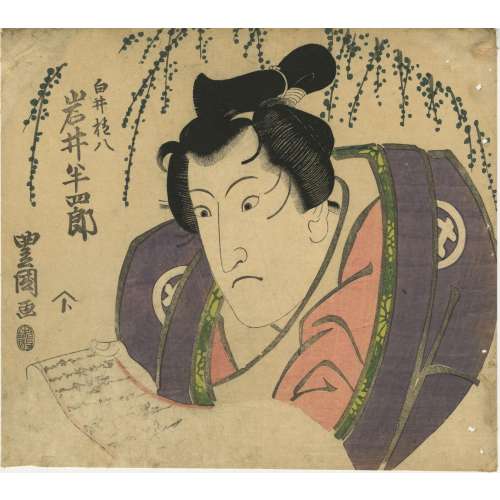 NEWKabuki actor Iwai Hanshiro V, in the role of Shirai Gonpachi, stands under a willow tree (yanagi, 柳) to read a letter from the courtesan Komurasaki of the Miuraya [三浦屋小紫]. In this letter, Komurasaki laments their unfortunate love. This is a scene from the kabuki play The Floating World's Pattern and Matching Lightning Bolts (Ukiyozuka hiyoku no inazuma) [浮世柄比翼稲妻] written by Tsurya Namboku IV [鶴屋南北]; it was played for the first time in March 1823 at Ichimura Theatre [市村座] in Edo. This play was later divided into two individual pieces: Saya-ate [鞘当] and Fuwa [不破]. On the shoulders of the actor's garment is a character 井 in a circle — both names, Iwai 岩井 and Shirai 白井, use this character.
NEWKabuki actor Iwai Hanshiro V, in the role of Shirai Gonpachi, stands under a willow tree (yanagi, 柳) to read a letter from the courtesan Komurasaki of the Miuraya [三浦屋小紫]. In this letter, Komurasaki laments their unfortunate love. This is a scene from the kabuki play The Floating World's Pattern and Matching Lightning Bolts (Ukiyozuka hiyoku no inazuma) [浮世柄比翼稲妻] written by Tsurya Namboku IV [鶴屋南北]; it was played for the first time in March 1823 at Ichimura Theatre [市村座] in Edo. This play was later divided into two individual pieces: Saya-ate [鞘当] and Fuwa [不破]. On the shoulders of the actor's garment is a character 井 in a circle — both names, Iwai 岩井 and Shirai 白井, use this character.
More information about the play and the real story behind it can be found at Lyon Collection. Actor: Iwai Hanshirō V [岩井半四郎] (Japanese, 1776 – 1847); other names: Iwai Tojaku, Iwai Kumesaburō I. Role: Shirai Gonpachi [白井権八] Artist: Utagawa Toyokuni I [歌川豊国] (1769–1825). Signed: Toyokuni ga [豊国画]. Publisher: Enshūya Matabei [遠州屋又兵衛] (Enterprise, active c. 1768 – 1881); seal: “to” (ト) under roof (Marks 01-031 | 057a). Date-aratame censor seal: 未改, Bunsei 6 (1823). Media: Aiban yoko-e uchiwa-e 団扇絵), 233 x 260 mm."Ukiyozuka Hiyoku no Inazuma" is a kabuki play in nine acts, written by Tsuruya Nanboku IV. It premiered in Bunsei 6 (1823) at the Ichimura-za theatre in Edo.
The play includes two particularly famous scenes:
- "Suzugamori no ba" (The Scene at Suzugamori), which portrays the episode of Banzuiin Chōbei and Shirai Gonpachi
- "Yoshiwara Nakanochō no ba" (The Scene at Yoshiwara Nakanochō), which depicts the story of Nagoya Sanza and Fuwa Banzaemon
These scenes have been frequently performed under the well-known titles "Gozonji Suzugamori" (A Well-Known Suzugamori) and "Sayaate" (The Scabbard Clash).
-
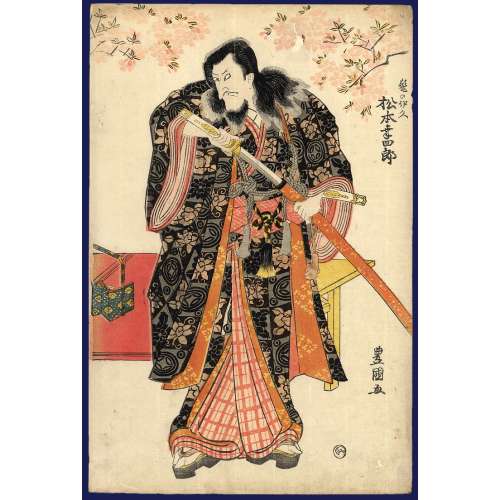 Artist: Utagawa Toyokuni I (1769–1825) Actor Matsumoto Kōshirō V plays the role of Ikyû in the drama "Sukeroku Yukari no Edo Zakura". The roles of Sukeroku and the courtesan Agemaki are played by Ichikawa Danjûrô VII and Iwai Hanshirô V". Ichimura Theater in Edo in 2nd lunar month of 1811. Publisher: Chōjiya Kichi (1811-1826); Marks' "Publishers" № 028, p. 103. Size: Vertical ôban Woodblock print (nishiki-e); ink and color on paper. Signed: Toyokuni ga My print is the right sheet of a triptych (see: Rare books exhibition in January 2013).
Artist: Utagawa Toyokuni I (1769–1825) Actor Matsumoto Kōshirō V plays the role of Ikyû in the drama "Sukeroku Yukari no Edo Zakura". The roles of Sukeroku and the courtesan Agemaki are played by Ichikawa Danjûrô VII and Iwai Hanshirô V". Ichimura Theater in Edo in 2nd lunar month of 1811. Publisher: Chōjiya Kichi (1811-1826); Marks' "Publishers" № 028, p. 103. Size: Vertical ôban Woodblock print (nishiki-e); ink and color on paper. Signed: Toyokuni ga My print is the right sheet of a triptych (see: Rare books exhibition in January 2013). A lookalike triptych by Kunisada can be found in Ronin Gallery:
A lookalike triptych by Kunisada can be found in Ronin Gallery:
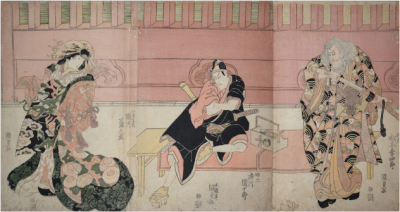 Data from Kabuki21:
Stage names:
Matsumoto Kôshirô V, Ichikawa Komazô III, Ichikawa Sumizô I
Guild: Kôraiya
Line number: GODAIME (V)
Poetry names: Kinshô, Kinkô
Existence: 1764 ~ 10th day of the 5th lunar month of 1838
Connection:
Father: Matsumoto Kôshirô IV
Sons: Matsumoto Kôshirô VI, Ichikawa Sumizô II
Disciples: Matsumoto Kojirô, Matsumoto Kingo I, Matsumoto Hidejûrô II
Data from Kabuki21:
Stage names:
Matsumoto Kôshirô V, Ichikawa Komazô III, Ichikawa Sumizô I
Guild: Kôraiya
Line number: GODAIME (V)
Poetry names: Kinshô, Kinkô
Existence: 1764 ~ 10th day of the 5th lunar month of 1838
Connection:
Father: Matsumoto Kôshirô IV
Sons: Matsumoto Kôshirô VI, Ichikawa Sumizô II
Disciples: Matsumoto Kojirô, Matsumoto Kingo I, Matsumoto Hidejûrô II
Matsumoto Kôshirô V was one of the Kabuki giants, a senryô yakusha, during the Bunka, Bunsei and Tenpô eras. In his 20's he was a tachiyaku actor excelling in nimaime roles like Soga Jûrô Sukenari in sogamono dramas. He started to perform jitsuaku roles from the 11th lunar month of 1798 and quickly became one of the best actors for villain roles, especially in Tsuruya Nanboku IV's kizewamono. He had a considerable influence on actors like Onoe Kikugorô III or Ichikawa Danjûrô VII. The kata he deviced for some of the most famous roles in Kabuki history, like Gonta ("Sushiya") or Nikki Danjô* ("Meiboku Sendai Hagi") are still used nowadays. "The fifth Kôshirô had a very large nose and his eyes were close together, two facial defects the print artists were fond of depicting, so that this Edo actor is easily picked out in the pictures illustrating the theatre of this time." (Zoë Kincaid in "Kabuki, the Popular Stage of Japan")
-
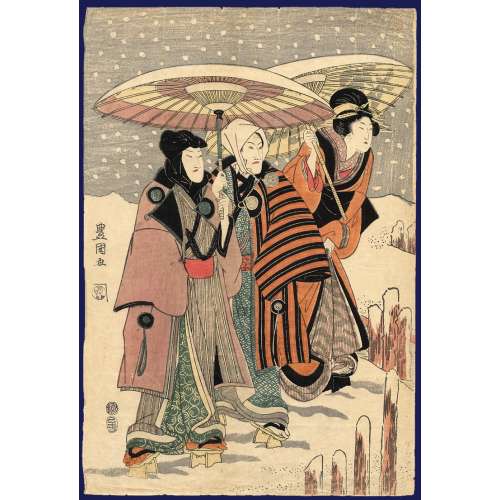 Similar image at MFA under title: Actors and Women in the Snow MFA ACCESSION NUMBER: 11.13568 Date: 1809 (Bunka 6), 12th month Artist: Utagawa Toyokuni I (1769–1825) Publisher Tsuruya Kinsuke (firm name Sôkakudô), № 554 in Marks's "Publishers". DIMENSIONS: Vertical ôban; 38.2 x 25.8 cm (15 1/16 x 10 3/16 in.) MEDIUM OR TECHNIQUE: Woodblock print (nishiki-e); ink and color on paper. Signed: Toyokuni ga (豊国画) Censor's seals: kiwame (改印:極) MFA assumes that this may be "one sheet of incomplete triptych?"
Similar image at MFA under title: Actors and Women in the Snow MFA ACCESSION NUMBER: 11.13568 Date: 1809 (Bunka 6), 12th month Artist: Utagawa Toyokuni I (1769–1825) Publisher Tsuruya Kinsuke (firm name Sôkakudô), № 554 in Marks's "Publishers". DIMENSIONS: Vertical ôban; 38.2 x 25.8 cm (15 1/16 x 10 3/16 in.) MEDIUM OR TECHNIQUE: Woodblock print (nishiki-e); ink and color on paper. Signed: Toyokuni ga (豊国画) Censor's seals: kiwame (改印:極) MFA assumes that this may be "one sheet of incomplete triptych?" -
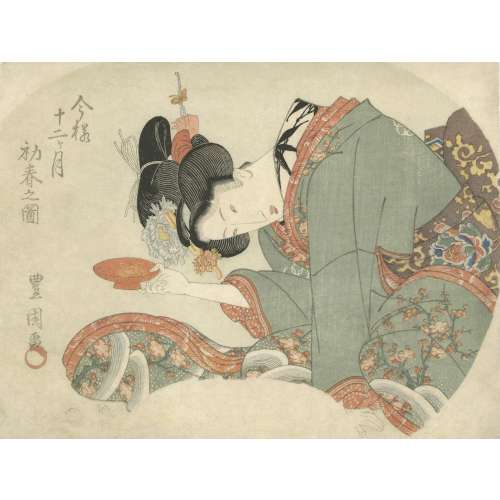 Title: Early Spring [初春之図] (Hatsuharu no zu); Series: Fashionable Twelve Months [今様十二ヶ月] (Imayo juni-kagetsu). Another version of translation: Modern Beauties of Twelve Months. Artist: Utagawa Toyokuni I [歌川豊国] (1769–1825). Pubisher: Ibaya Senzaburō [伊場屋仙三郎] (Japanese, 1815 – 1869), seal: Dansendō [伊場仙]. Signed: Toyokuni ga [豊国画] and sealed with toshidama. Date-kiwame seal: Ushi (ox), Bunsei 5 (1822). Size: double-sheet uncut fan print ( aiban uchiwa-e), each 217 x 288 mm. Ref: Tokyo Museum Collection.
Title: Early Spring [初春之図] (Hatsuharu no zu); Series: Fashionable Twelve Months [今様十二ヶ月] (Imayo juni-kagetsu). Another version of translation: Modern Beauties of Twelve Months. Artist: Utagawa Toyokuni I [歌川豊国] (1769–1825). Pubisher: Ibaya Senzaburō [伊場屋仙三郎] (Japanese, 1815 – 1869), seal: Dansendō [伊場仙]. Signed: Toyokuni ga [豊国画] and sealed with toshidama. Date-kiwame seal: Ushi (ox), Bunsei 5 (1822). Size: double-sheet uncut fan print ( aiban uchiwa-e), each 217 x 288 mm. Ref: Tokyo Museum Collection.
Other five prints of this series: SVJP 0326.2020; SVJP-0362.2022; SVJP-0363.2022; SVJP-0364.2022; SVJP-0365.2022.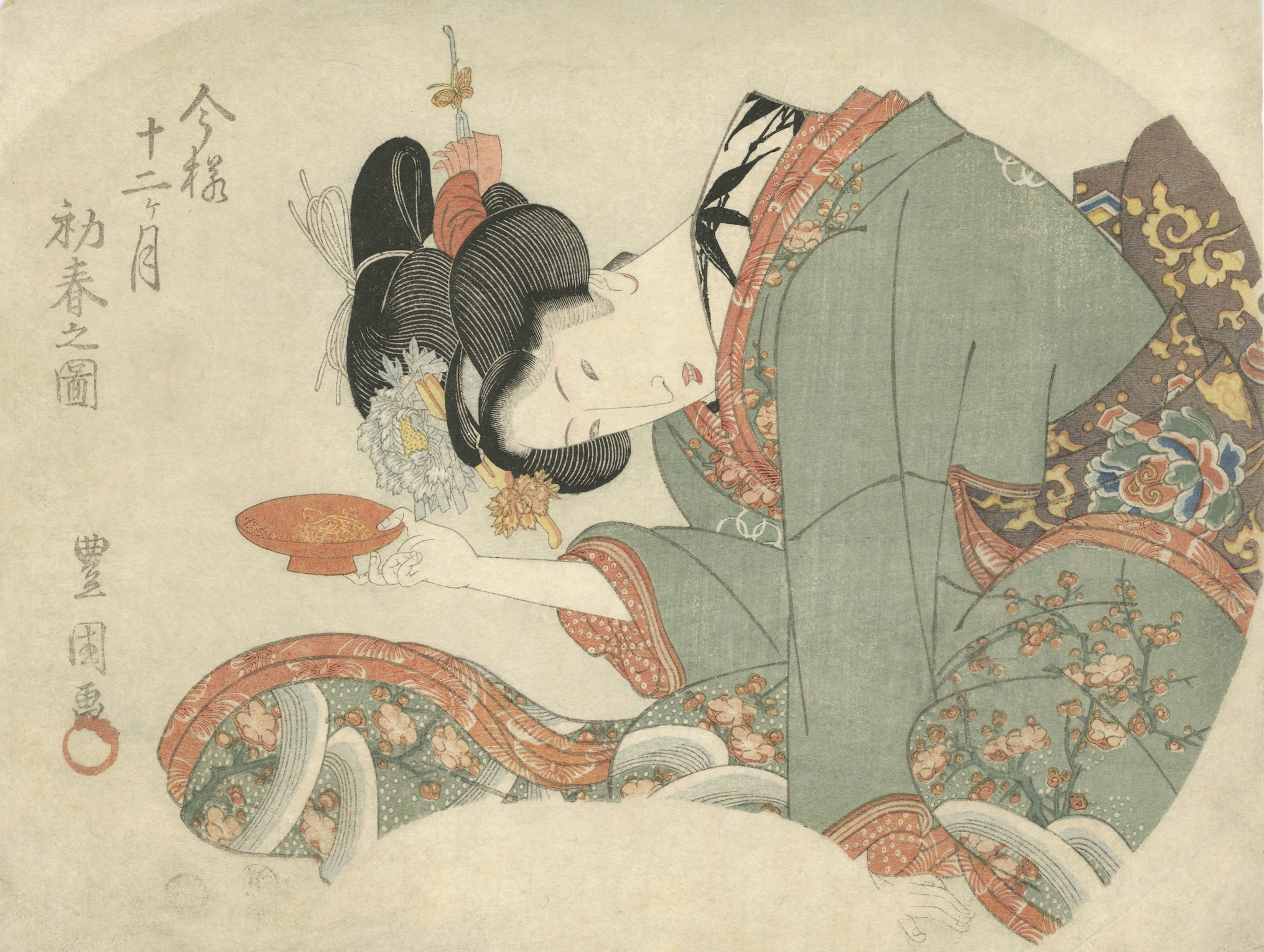
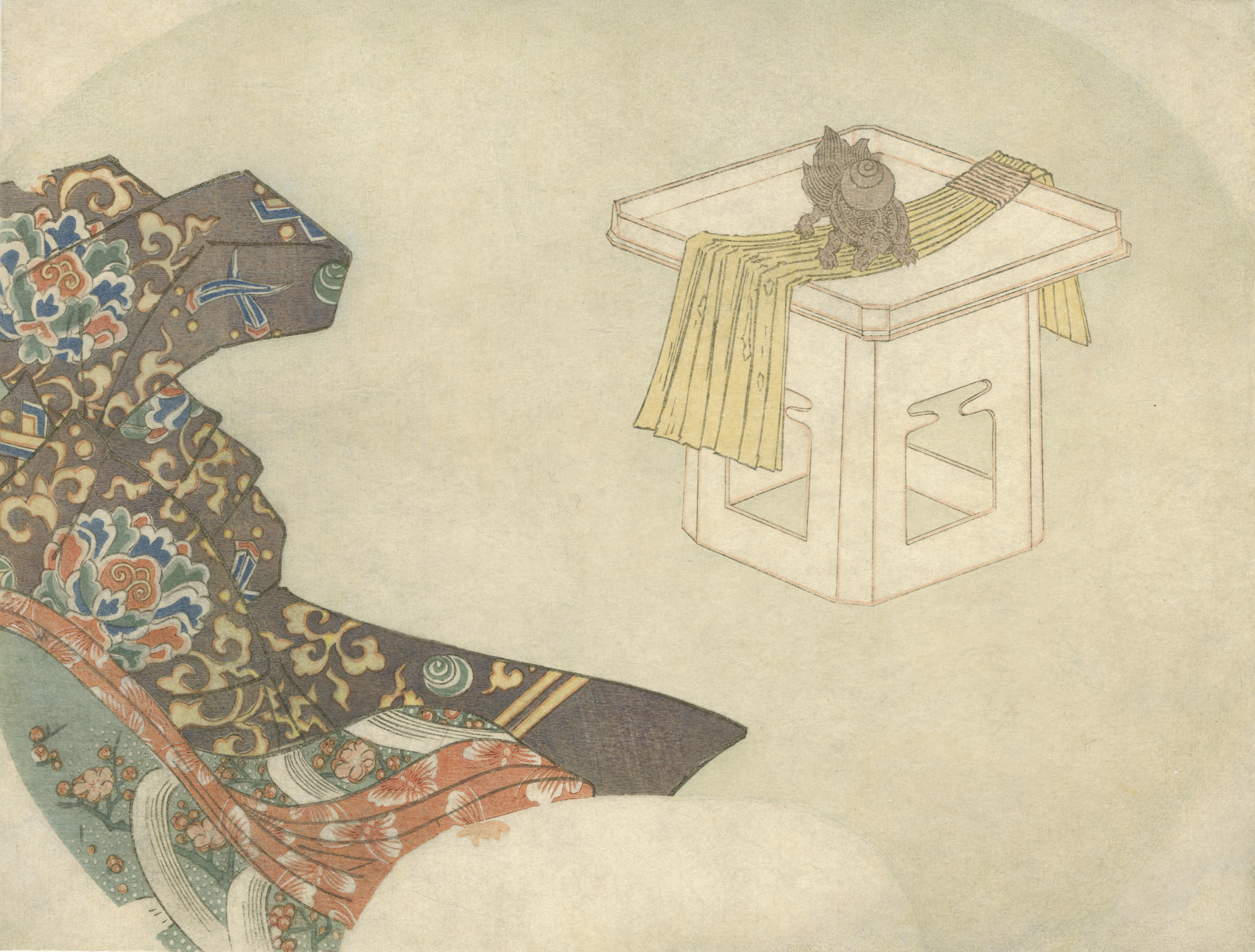
-
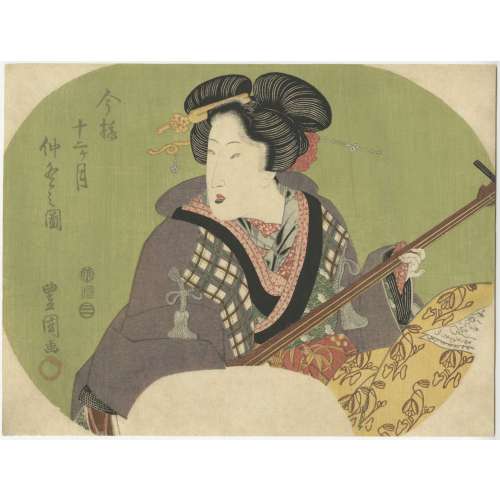 Title: Eleventh lunar month (Chuto no zu); Series: Fashionable Twelve Months (Imayo juni-kagetsu). Another version of translation: Modern Beauties of Twelve Months. Artist: Utagawa Toyokuni I [歌川豊国] (1769–1825). Pubisher: Ibaya Senzaburō [伊場屋仙三郎] (Japanese, 1815 – 1869), seal: Dansendō [伊場仙]. Signed: Toyokuni ga and sealed with toshidama. Date-kiwame seal: Ushi (ox), Bunsei 5 (1822). Size: double-sheet uncut fan print ( aiban uchiwa-e), 219 x 295 mm.
Title: Eleventh lunar month (Chuto no zu); Series: Fashionable Twelve Months (Imayo juni-kagetsu). Another version of translation: Modern Beauties of Twelve Months. Artist: Utagawa Toyokuni I [歌川豊国] (1769–1825). Pubisher: Ibaya Senzaburō [伊場屋仙三郎] (Japanese, 1815 – 1869), seal: Dansendō [伊場仙]. Signed: Toyokuni ga and sealed with toshidama. Date-kiwame seal: Ushi (ox), Bunsei 5 (1822). Size: double-sheet uncut fan print ( aiban uchiwa-e), 219 x 295 mm.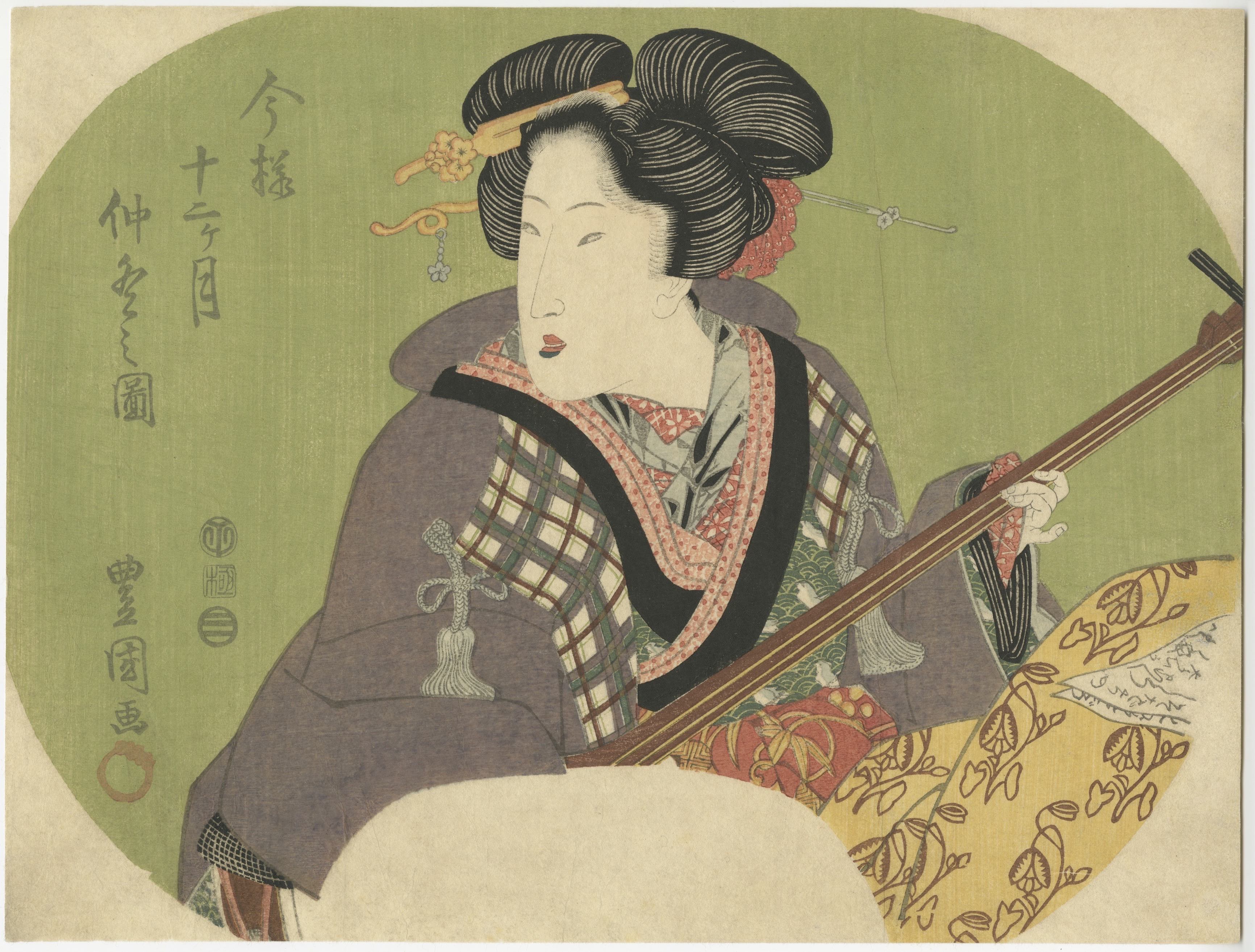
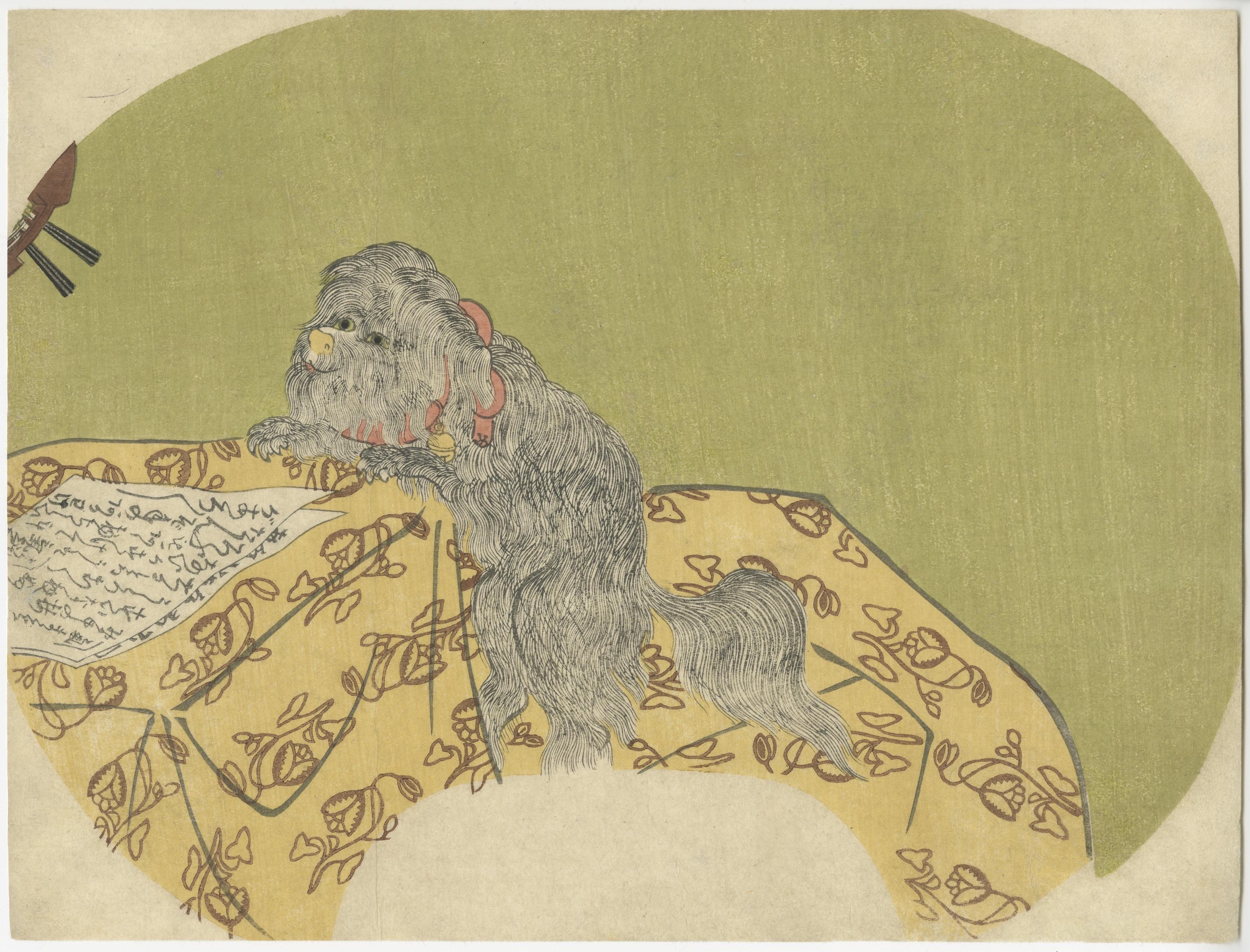
-
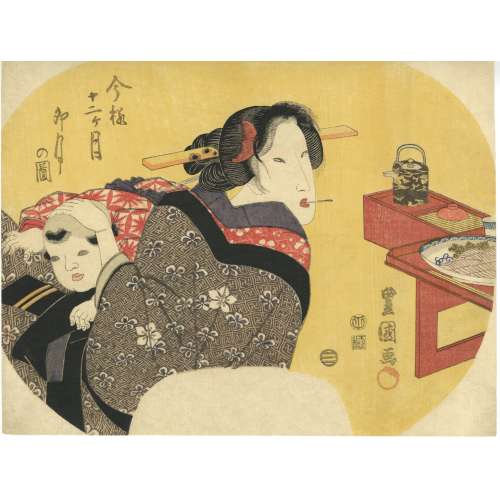 Title: Fourth lunar month [卯月] (Uzuki no zu); Series: Fashionable Twelve Months (Imayo juni-kagetsu). Another version of translation: Modern Beauties of Twelve Months. Artist: Utagawa Toyokuni I [歌川豊国] (1769–1825). Pubisher: Ibaya Senzaburō [伊場屋仙三郎] (Japanese, 1815 – 1869), seal: Dansendō [伊場仙]. Signed: Toyokuni ga and sealed with toshidama. Date-kiwame seal: Ushi (ox), Bunsei 5 (1822). Size: double-sheet uncut fan print ( aiban uchiwa-e), 219 x 295 mm.
Title: Fourth lunar month [卯月] (Uzuki no zu); Series: Fashionable Twelve Months (Imayo juni-kagetsu). Another version of translation: Modern Beauties of Twelve Months. Artist: Utagawa Toyokuni I [歌川豊国] (1769–1825). Pubisher: Ibaya Senzaburō [伊場屋仙三郎] (Japanese, 1815 – 1869), seal: Dansendō [伊場仙]. Signed: Toyokuni ga and sealed with toshidama. Date-kiwame seal: Ushi (ox), Bunsei 5 (1822). Size: double-sheet uncut fan print ( aiban uchiwa-e), 219 x 295 mm.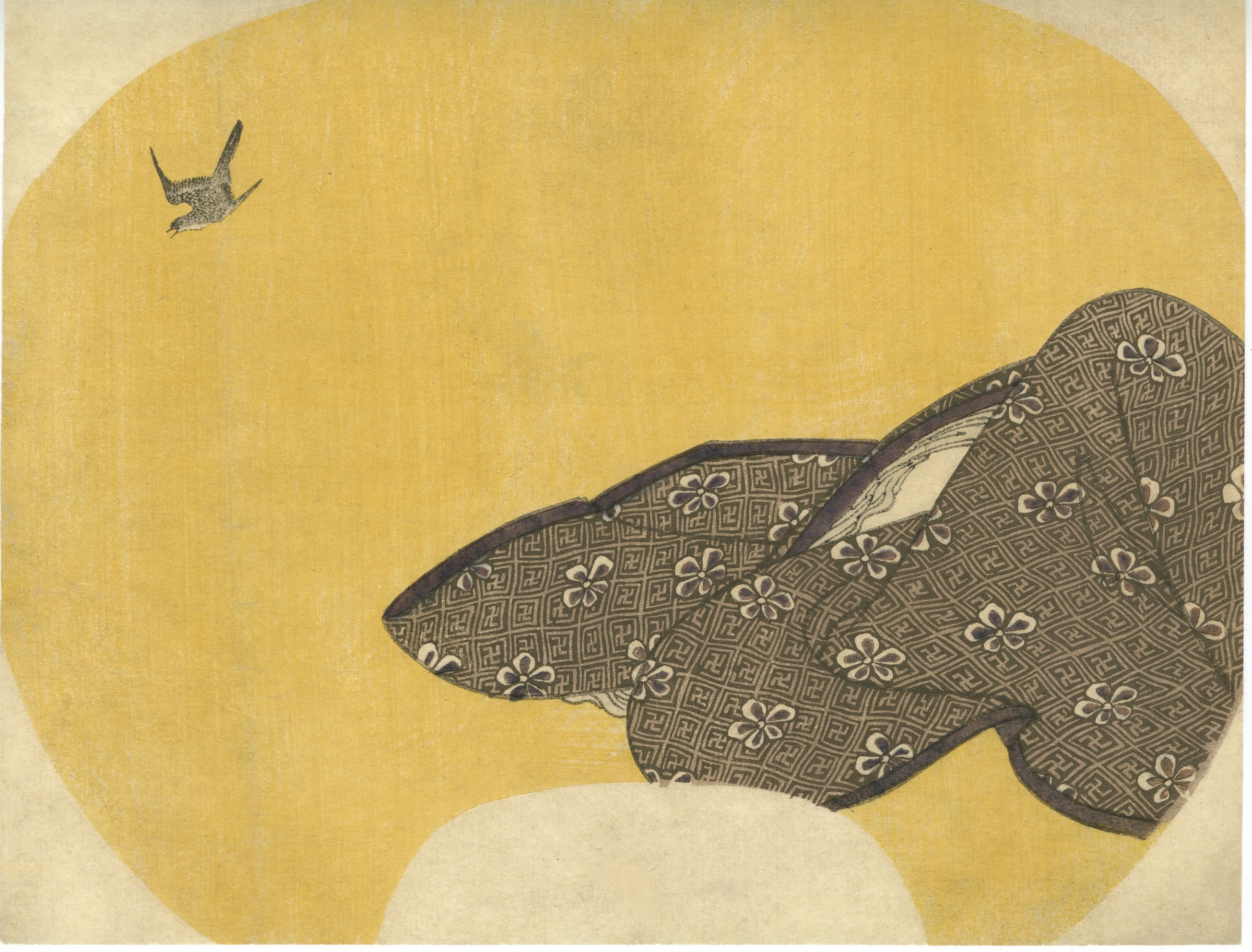
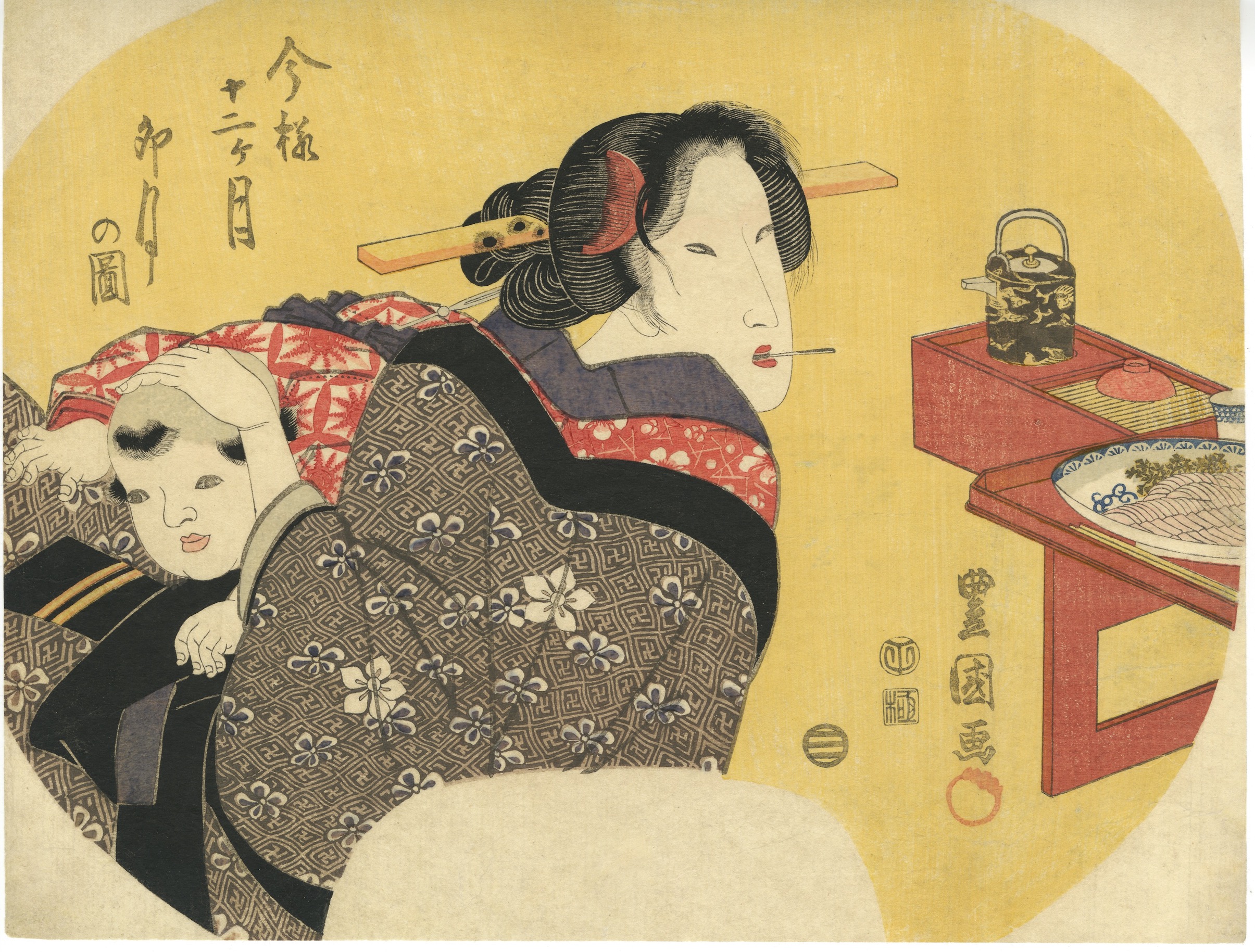
-
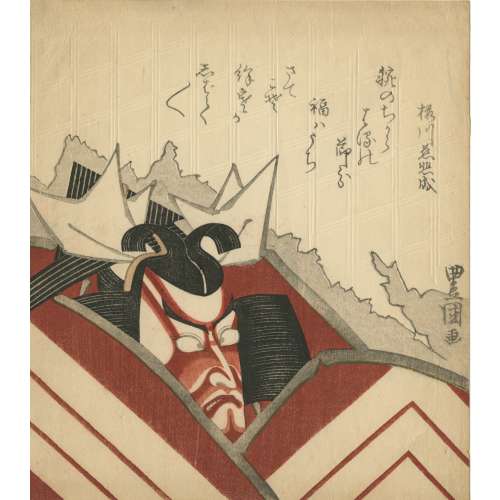 UTAGAWA TOYOKUNI I (1769–1825) Ichikawa Danjūrō VII (Ebizo V) in a shibaraku costume bursting through a paper screen. Surimono. Colour woodblock print: shikishiban, 8⅛ x 7⅛ in. (20.7 x 18.2 cm) Signed: Toyokuni ga Poem signed: Sakuragawa Jihinari Provenance: Sidney C. Ward
UTAGAWA TOYOKUNI I (1769–1825) Ichikawa Danjūrō VII (Ebizo V) in a shibaraku costume bursting through a paper screen. Surimono. Colour woodblock print: shikishiban, 8⅛ x 7⅛ in. (20.7 x 18.2 cm) Signed: Toyokuni ga Poem signed: Sakuragawa Jihinari Provenance: Sidney C. Ward -
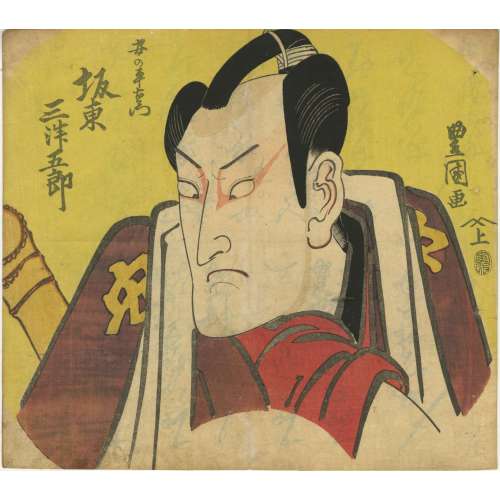 NEW
NEWArtist: Utagawa Toyokuni I [初代豊国] (Japanese, 1769–1825)
Publisher: Iseya Sōemon [伊勢屋惣右衛門] (c. 1776 – November 1862); Marks 02-041 | 156a
Date-Aratame Seal: Bunsei 1 (文政元年, 1818)
Media: Print (Yakusha-e, 役者絵); 223 x 250 mm
Actor: Bandō Mitsugorō III [三代目 坂東 三津五郎] (Japanese, 1775–1831); also known as Bandō Minosuke I, Morita Kanjirō II, Bandō Mitahachi I, Bandō Minosuke I, Bandō Mitahachi I.
Role: Anno Heiemon [安の平右衛門], also known as Anno Heibei [安の平兵衛].
Play: Shiire Zome Karigane Gomon [仕入染雁金五紋] (しいれぞめかりがねごもん), staged in May 1818 at Nakamuraza Theatre in Edo (modern-day Tokyo).
Bust-length, three-quarter-view portrait of actor Bandō Mitsugorō III as Anno Heibei, one of the gonin otoko [五人男]—a group of five chivalrous thieves. The actor is dressed in a red and purple robe, with a golden mon (family crest) on the shoulders, displaying the character 安 (An), which, in this case, represents the first ideogram in the name of his role. A shakuhachi (尺八), a traditional Japanese end-blown bamboo flute, is secured on his back.
-
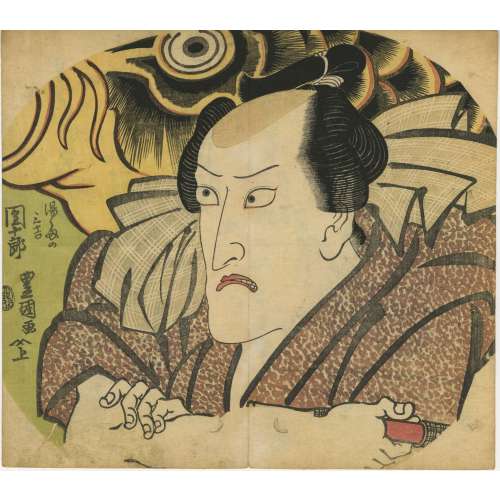 NEWArtist: Utagawa Toyokuni I [初代豊国] (Japanese, 1769–1825) Signed: Toyokuni ga [豊国画]. Publisher: Iseya Sōemon [伊勢屋惣右衛門] (c. 1776 – November 1862); Marks 02-041 | 156a Date-Aratame Seal: 1819 (Bunsei 2, 文政二年) Media: Print (Yakusha-e, 役者絵); 221 x 253 mm
NEWArtist: Utagawa Toyokuni I [初代豊国] (Japanese, 1769–1825) Signed: Toyokuni ga [豊国画]. Publisher: Iseya Sōemon [伊勢屋惣右衛門] (c. 1776 – November 1862); Marks 02-041 | 156a Date-Aratame Seal: 1819 (Bunsei 2, 文政二年) Media: Print (Yakusha-e, 役者絵); 221 x 253 mmActor: Ichikawa Danjūrō VII [七代目市川團十郎] (Japanese, 1791–1859); Other names: Ichikawa Ebizō V (五代目市川海老蔵), Ichikawa Hakuen II (二代目市川白猿), Ichikawa Shinnosuke I (初代市川新之助).
Role: Yushima no Sankichi (ゆしまの三吉) Play: Ume Yanagi Wakaba no Kagazome (梅柳若葉加賀染) Theater: Tamagawa-za (玉川座), Edo, May 1819 Bust-length, three-quarter-view portrait of Ichikawa Danjūrō VII as Yushima no Sankichi, in the play Ume Yanagi Wakaba no Kagazome, staged at Tamagawa-za in May 1819. The actor is depicted with his arms crossed over his chest, holding a pipe (kiseru, 煙管) in his right hand. The upper half of the background features a giant golden carp (鯉, koi), symbolizing Boys' Day (Tango no Sekku) (端午の節句), celebrated on May 5th each year. This print forms a pair with the portrait of Kabuki actor Segawa Kikunojō V as Kurenaiya Okan [SVJP-0440.2025], but no conclusive information is available regarding the relationship between their characters.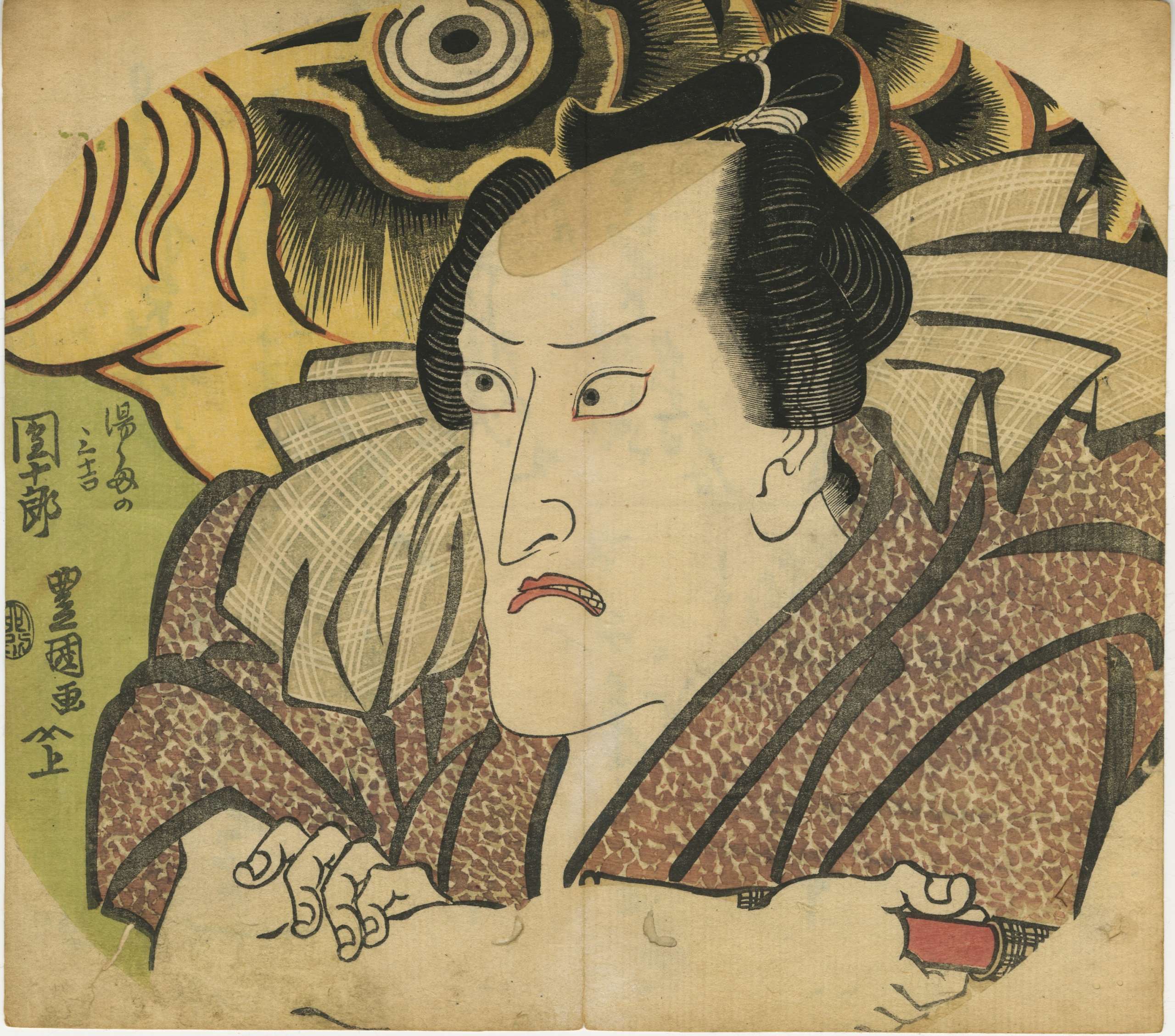
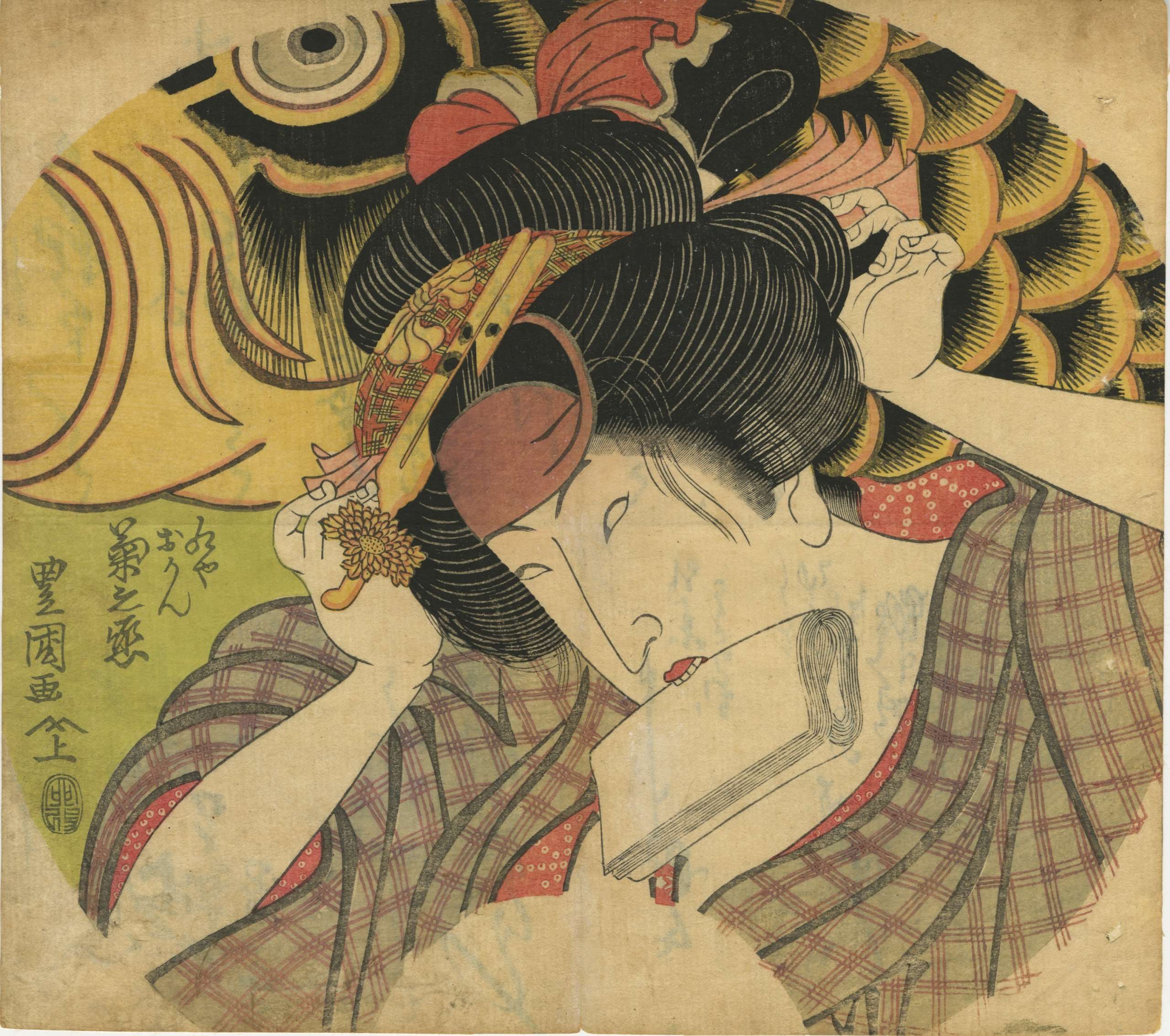
-
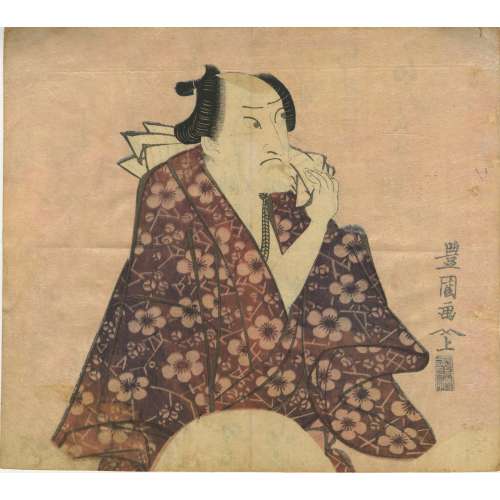 NEWArtist: Utagawa Toyokuni I [初代豊国] (Japanese, 1769–1825) Signed: Toyokuni ga [豊国画] Publisher: Iseya Sōemon [伊勢屋惣右衛門] (c. 1776 – November 1862); Marks 02-041 | 156a Gyōji Aratame Censor Seal: 行事改, 1810-18151 Media: Print (Uchiwa-e, うちわ絵, fan print), kira-zuri (きら摺り, mica printing); 222 × 250 mm
NEWArtist: Utagawa Toyokuni I [初代豊国] (Japanese, 1769–1825) Signed: Toyokuni ga [豊国画] Publisher: Iseya Sōemon [伊勢屋惣右衛門] (c. 1776 – November 1862); Marks 02-041 | 156a Gyōji Aratame Censor Seal: 行事改, 1810-18151 Media: Print (Uchiwa-e, うちわ絵, fan print), kira-zuri (きら摺り, mica printing); 222 × 250 mmActor: Onoe Baikō III [三代目尾上梅幸] (Japanese, 1784–1849); Other names: Onoe Kikugorō III (尾上菊五郎), Ōkawa Hashizō I (大川橋蔵初代), Onoe Matsusuke II (二代目尾上松助), Onoe Eizaburō I (初代尾上栄三郎)
Role: Konjin Chōgorō (金神長五郎) Play: Ku Kyōdai Shōbu Katabira (句兄弟菖蒲帷子) Theater: Nakamura-za (中村座), Edo, 1815 Half-length, three-quarter-view, facing to the left portrait of Onoe Baikō III as Konjin Chōgorō, in the play Ku Kyōdai Shōbu Katabira, staged at Nakamura-za in 1815. The actor wears a purple kimono with a plum blossom motif (梅, ume).A print from the Waseda University Tsubouchi Memorial Theatre Museum also depicts Onoe Baikō III as Konjin Chōgorō, showing him holding a box inscribed with 神金 (Kane no Kami). The name Konjin consists of the same kanji reading right to left (金神).
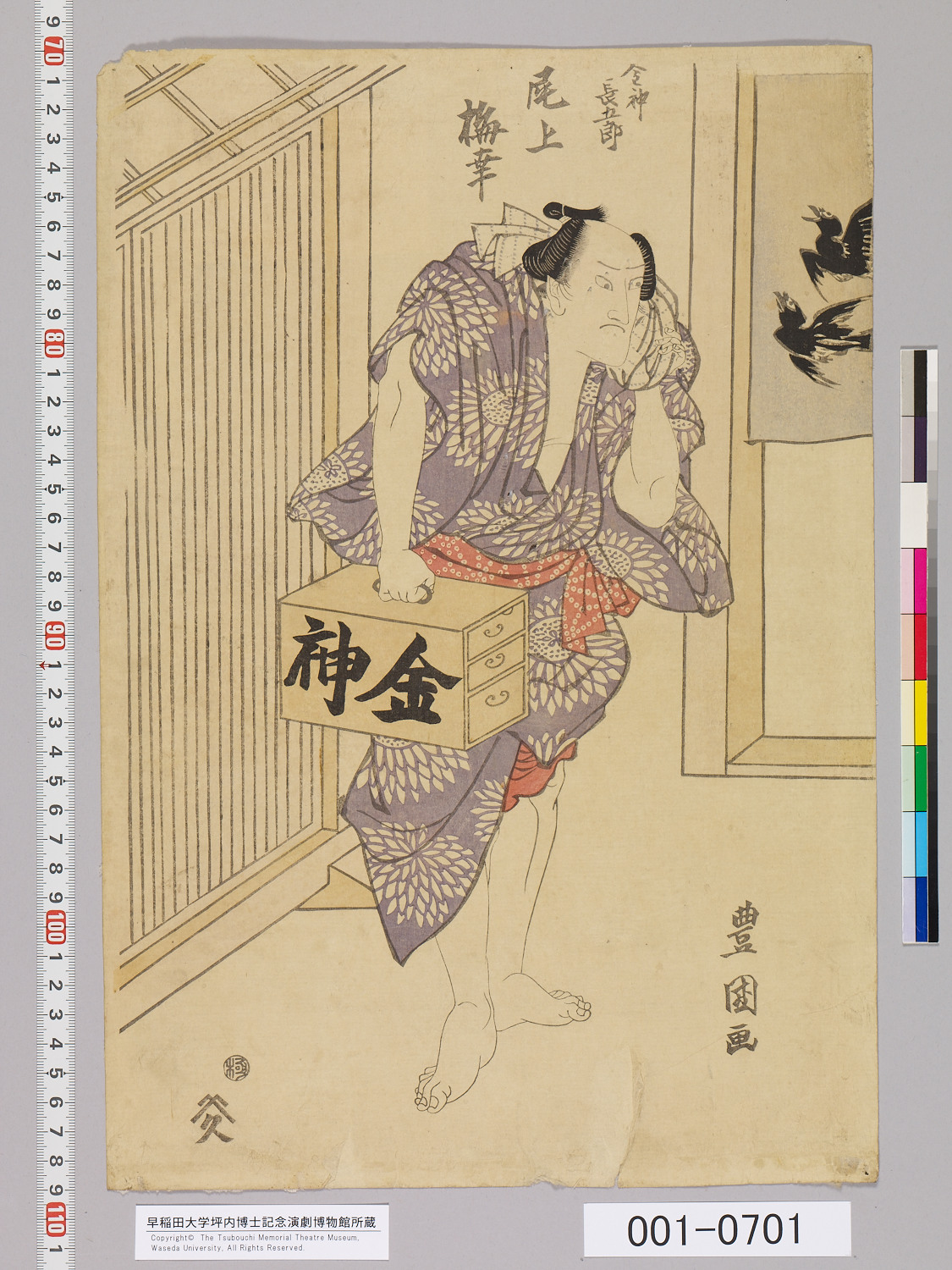
Konjin Chōgorō is a legendary figure in Japanese folklore, renowned as a formidable sumo wrestler. His tales often depict him engaging in supernatural feats, such as vanquishing demons and showcasing extraordinary strength.
In the realm of kabuki theatre, Konjin Chōgorō's character has been portrayed in various plays, though specific details about Ku Kyōdai Shōbu Katabira (句兄弟菖蒲帷子) remain unknown.
Notes
-
A certain confusion regarding the attribution of this print arises from the statement by Andreas Marks (Publishers, 2011, p. 488), which asserts that the gyōji aratame seal was used exclusively for fan prints between 1810 and 1814. However, it is known that Onoe Baikō III performed the role of Konjin Chōgorō at Nakamura-za in the 5th month of 1815. Marks also notes that the earliest known fan print bearing this seal dates to 1810; based on this new evidence, we may now consider the latest known instance to be the 5th month of 1815.
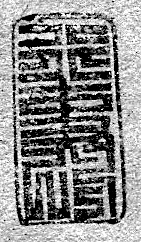
-
-
 NEWArtist: Utagawa Toyokuni I [初代豊国] (Japanese, 1769–1825) Signed: Toyokuni ga [豊国画]. Publisher: Iseya Sōemon [伊勢屋惣右衛門] (c. 1776 – November 1862); Marks 02-041 | 156a Date-Aratame Seal: 1819 (Bunsei 2, 文政二年) Media: Print (Yakusha-e, 役者絵); 221 × 253 mm Play: Ume Yanagi Wakaba no Kagazome (梅柳若葉加賀染) Theater: Tamagawa-za (玉川座), Edo, May 1819 Role: Kurenaiya Okan (紅屋おかん) Actor: Segawa Kikunojō V [瀬川菊之丞] (Japanese, 1802–1832); Other name: Segawa Tamon I (瀬川多聞初代) Bust-length, three-quarter-view portrait of Segawa Kikunojō V as Kurenaiya Okan in the play Ume Yanagi Wakaba no Kagazome, staged at Tamagawa-za in May 1819. The male actor Segawa Kikunojō V performs an onnagata role, portraying a courtesan. She is depicted adjusting her elaborate shimadamage-style coiffure, fixing a kanzashi (簪, hairpin) while holding onkotogami (御懲紙, tissue paper) in her mouth. The onkotogami was traditionally used for intimate hygiene, suggesting that the scene represents a moment after encountering a client. Her inner kimono is safflower-dyed and has a hemp leaf pattern (麻の葉, asa no ha). The top half of the background features a giant golden carp (鯉, koi), a recurring motif in this pair of prints often associated with strength, perseverance, and kabuki’s aragoto style. This print forms a pair with the portrait of Ichikawa Danjūrō VII as Yushima no Sankichi [SVJP-0439.2025], but no conclusive information is available regarding the relationship between their characters. The carp also alludes to Boys' Day (Tango no Sekku, 端午の節句), celebrated on May 5th each year.
NEWArtist: Utagawa Toyokuni I [初代豊国] (Japanese, 1769–1825) Signed: Toyokuni ga [豊国画]. Publisher: Iseya Sōemon [伊勢屋惣右衛門] (c. 1776 – November 1862); Marks 02-041 | 156a Date-Aratame Seal: 1819 (Bunsei 2, 文政二年) Media: Print (Yakusha-e, 役者絵); 221 × 253 mm Play: Ume Yanagi Wakaba no Kagazome (梅柳若葉加賀染) Theater: Tamagawa-za (玉川座), Edo, May 1819 Role: Kurenaiya Okan (紅屋おかん) Actor: Segawa Kikunojō V [瀬川菊之丞] (Japanese, 1802–1832); Other name: Segawa Tamon I (瀬川多聞初代) Bust-length, three-quarter-view portrait of Segawa Kikunojō V as Kurenaiya Okan in the play Ume Yanagi Wakaba no Kagazome, staged at Tamagawa-za in May 1819. The male actor Segawa Kikunojō V performs an onnagata role, portraying a courtesan. She is depicted adjusting her elaborate shimadamage-style coiffure, fixing a kanzashi (簪, hairpin) while holding onkotogami (御懲紙, tissue paper) in her mouth. The onkotogami was traditionally used for intimate hygiene, suggesting that the scene represents a moment after encountering a client. Her inner kimono is safflower-dyed and has a hemp leaf pattern (麻の葉, asa no ha). The top half of the background features a giant golden carp (鯉, koi), a recurring motif in this pair of prints often associated with strength, perseverance, and kabuki’s aragoto style. This print forms a pair with the portrait of Ichikawa Danjūrō VII as Yushima no Sankichi [SVJP-0439.2025], but no conclusive information is available regarding the relationship between their characters. The carp also alludes to Boys' Day (Tango no Sekku, 端午の節句), celebrated on May 5th each year.

-
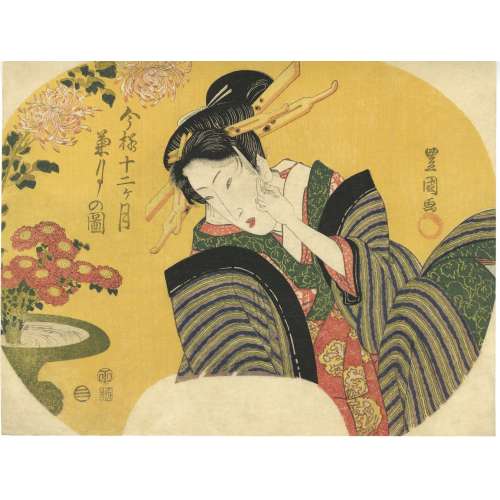 Title: Ninth lunar month [菊月] (Kikuzuki no zu); Series: Fashionable Twelve Months (Imayo juni-kagetsu). Another version of translation: Modern Beauties of Twelve Months. Artist: Utagawa Toyokuni I [歌川豊国] (1769–1825). Pubisher: Ibaya Senzaburō [伊場屋仙三郎] (Japanese, 1815 – 1869), seal: Dansendō [伊場仙]. Signed: Toyokuni ga and sealed with toshidama. Date-kiwame seal: Ushi (ox), Bunsei 5 (1822). Size: double-sheet uncut fan print ( aiban uchiwa-e), 219 x 295 mm.
Title: Ninth lunar month [菊月] (Kikuzuki no zu); Series: Fashionable Twelve Months (Imayo juni-kagetsu). Another version of translation: Modern Beauties of Twelve Months. Artist: Utagawa Toyokuni I [歌川豊国] (1769–1825). Pubisher: Ibaya Senzaburō [伊場屋仙三郎] (Japanese, 1815 – 1869), seal: Dansendō [伊場仙]. Signed: Toyokuni ga and sealed with toshidama. Date-kiwame seal: Ushi (ox), Bunsei 5 (1822). Size: double-sheet uncut fan print ( aiban uchiwa-e), 219 x 295 mm.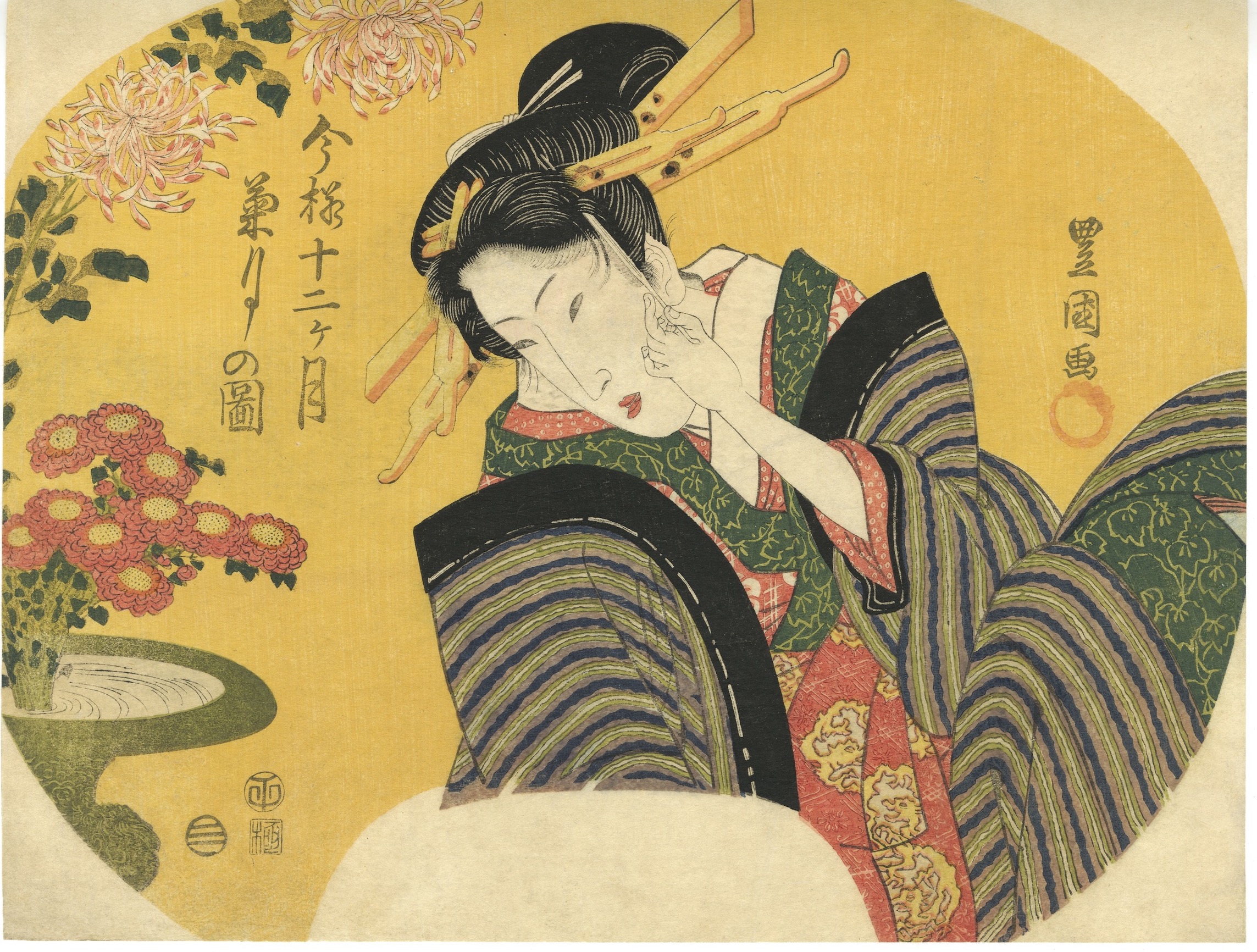
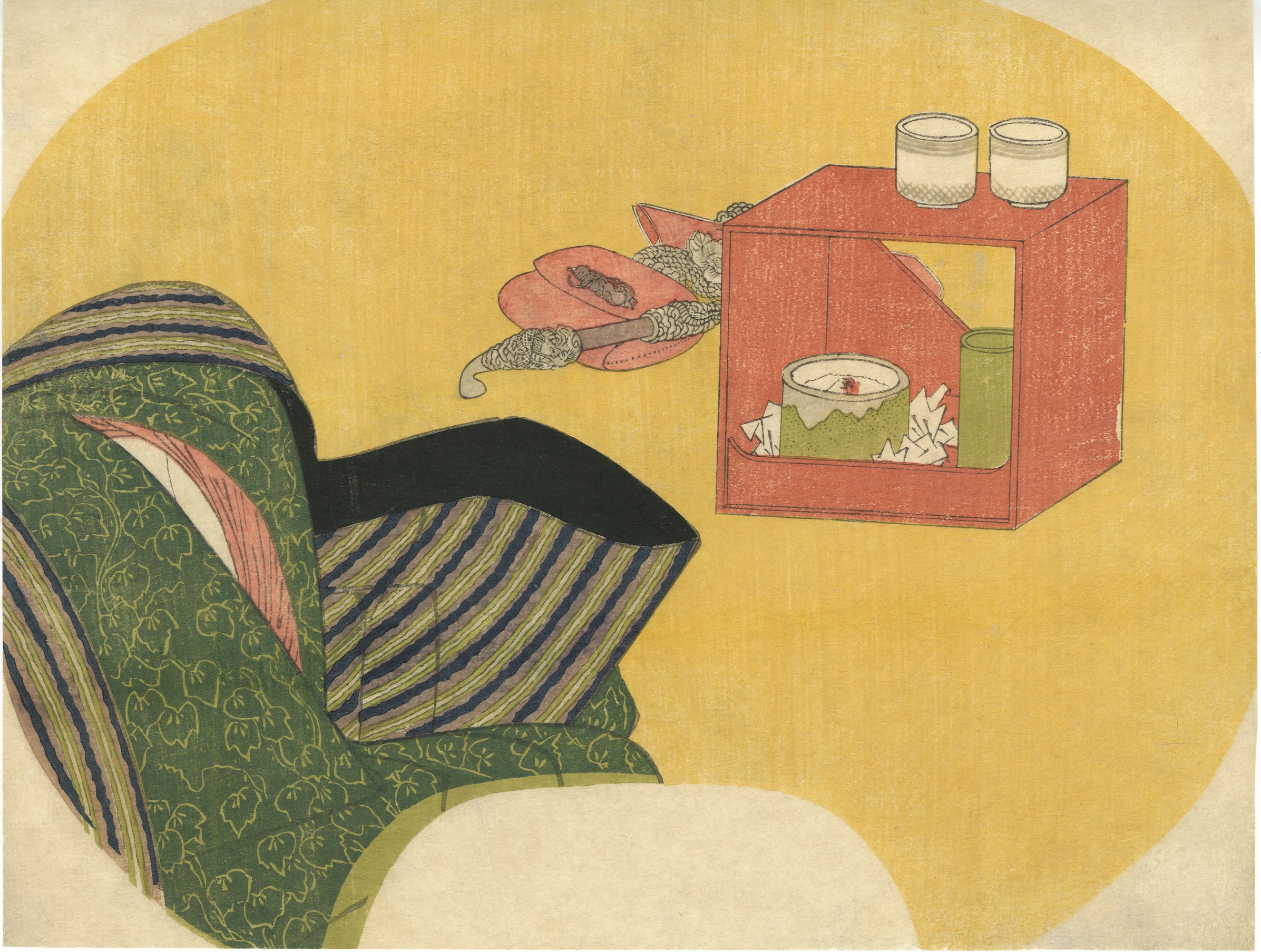
-
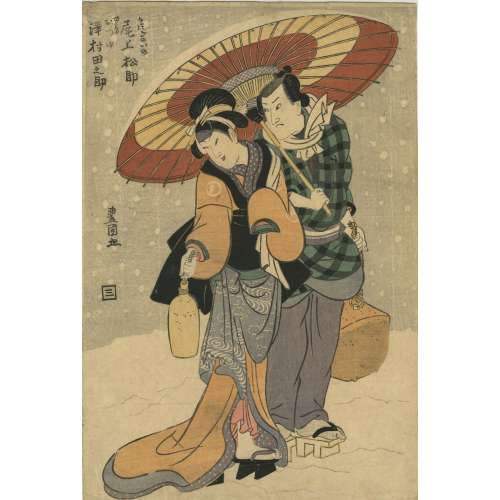 Utagawa Toyokuni (歌川豐國); 1769 – 24 February 1825. Actor Onoe Matsusuke II as Katsugiino (right), actor Sawamura Tanosuke II as Otsuyu (left) 尾上松助(二代目)in a role かつぎいの; 沢村田之助(二代目) in a role おつゆ. Play: "Yuki to Tsuki Hana no Kuronushi". Theater: Nakamura. Publisher: Mikawaua Seiemon (1805-1829) [Marks: 328]. Circa 1810.
Utagawa Toyokuni (歌川豐國); 1769 – 24 February 1825. Actor Onoe Matsusuke II as Katsugiino (right), actor Sawamura Tanosuke II as Otsuyu (left) 尾上松助(二代目)in a role かつぎいの; 沢村田之助(二代目) in a role おつゆ. Play: "Yuki to Tsuki Hana no Kuronushi". Theater: Nakamura. Publisher: Mikawaua Seiemon (1805-1829) [Marks: 328]. Circa 1810. -
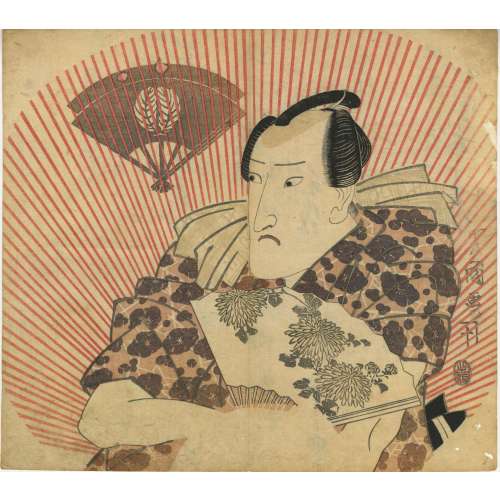 NEW
NEWArtist: Utagawa Toyokuni I [初代豊国] (Japanese, 1769–1825)
Signed: Toyokuni ga [豊国画]
Publisher: Kojimaya Jūbei [小嶋屋重兵衛] (Japanese, c. 1797–1869); seal [十]; Marks 06-014 | 264a
Date-Aratame Seal: 1822 (Bunsei 5, 文政五年)
Media: Print (Uchiwa-e, うちわ絵, fan print); 223 × 250 mm
Actor: Onoe Kikugorō III [三代目 尾上菊五郎] (Japanese, 1784–1849); other names: Onoe Baikō III (尾上梅幸), Ōkawa Hashizō I (大川橋蔵初代), Onoe Matsusuke II (二代目尾上松助), Onoe Eizaburō I (初代尾上栄三郎)
Half-length, three-quarter-view portrait of Onoe Kikugorō III, depicted without stage makeup. The actor wears a kimono patterned with plum blossoms (梅, ume), symbolising perseverance and longevity. A neck scarf with a 格子 (kōshi) pattern is visible, and he holds a folding fan (扇, ōgi) decorated with chrysanthemums (菊, kiku).
Above his head is the Onoe family crest (mon), embracing oak leaves on layered fans. This emblem, known as the crest of the Otowaya line, commemorates a shogunal gift of rice cakes wrapped in oak leaves, placed on a fan, and presented to Onoe Kikugorō I.
The background features a radiating red-line pattern, possibly representing the bamboo structure of an uchiwa fan. The absence of kumadori (歌舞伎隈取, kabuki makeup) suggests that the actor is not portrayed in a specific role.
In 1822, Onoe Kikugorō III performed at Kawarazaki-za before month 11 and at Ichimura-za and Nakamura-za afterwards.
The print has been backed for preservation with a sheet of paper featuring calligraphy, likely contemporary to the print itself. The backing paper appears to have been repurposed, a common historical practice in the Edo period, where discarded documents or manuscripts were reused to reinforce delicate prints.
Kunisada portrayed the same actor in 1815 as Rokusaburō, the Carpenter (Daiku Rokusaburō).
-
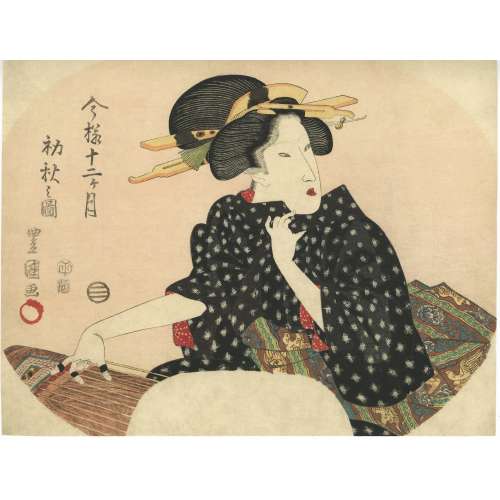 Title: Seventh lunar month [初秋] (Hatsuaki no zu); Series: Fashionable Twelve Months (Imayo juni-kagetsu). Another version of translation: Modern Beauties of Twelve Months. Artist: Utagawa Toyokuni I [歌川豊国] (1769–1825). Pubisher: Ibaya Senzaburō [伊場屋仙三郎] (Japanese, 1815 – 1869), seal: Dansendō [伊場仙]. Signed: Toyokuni ga and sealed with toshidama. Date-kiwame seal: Ushi (ox), Bunsei 5 (1822). Size: double-sheet uncut fan print ( aiban uchiwa-e), 219 x 295 mm.
Title: Seventh lunar month [初秋] (Hatsuaki no zu); Series: Fashionable Twelve Months (Imayo juni-kagetsu). Another version of translation: Modern Beauties of Twelve Months. Artist: Utagawa Toyokuni I [歌川豊国] (1769–1825). Pubisher: Ibaya Senzaburō [伊場屋仙三郎] (Japanese, 1815 – 1869), seal: Dansendō [伊場仙]. Signed: Toyokuni ga and sealed with toshidama. Date-kiwame seal: Ushi (ox), Bunsei 5 (1822). Size: double-sheet uncut fan print ( aiban uchiwa-e), 219 x 295 mm.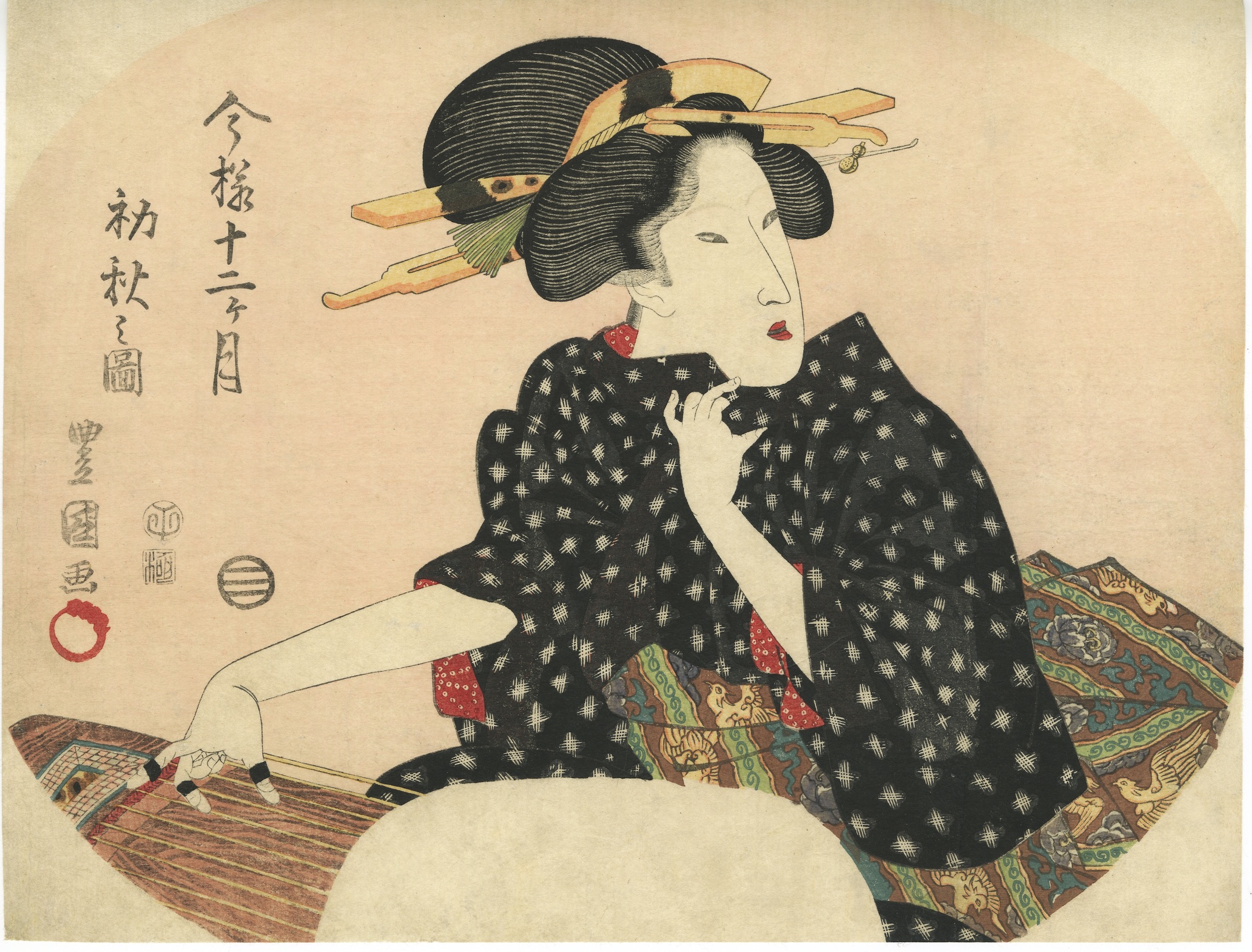
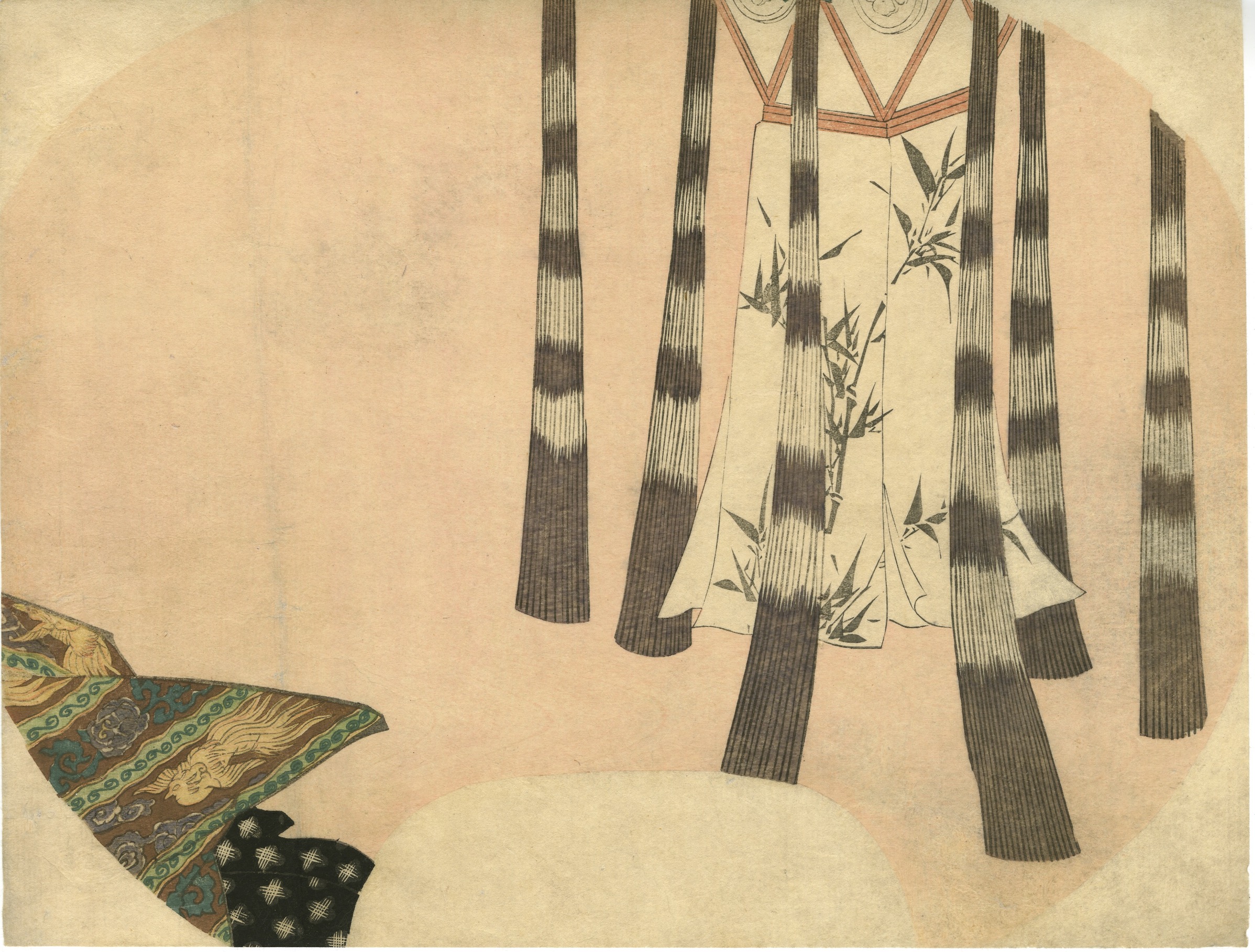
-
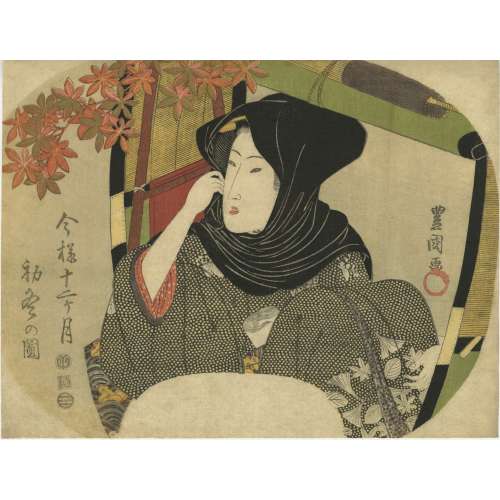 NEWTitle: Tenth lunar month (Shoto no zu) [初冬の図]. Series: Fashionable Twelve Months [今様十二ヶ月] (Imayo juni-kagetsu). Another version of the translation: Modern Beauties of Twelve Months. Artist: Utagawa Toyokuni I [歌川豊国] (1769–1825). Signed: Toyokuni ga [豊国画] and sealed with toshidama. Pubisher: Ibaya Senzaburō [伊場屋仙三郎] (Japanese, 1815 – 1869), seal: Dansendō [伊場仙]. Date-kiwame seal: Ushi (ox), Bunsei 5 (1822). Size: double-sheet uncut fan print (aiban uchiwa-e), each 220 x 289 mm.
NEWTitle: Tenth lunar month (Shoto no zu) [初冬の図]. Series: Fashionable Twelve Months [今様十二ヶ月] (Imayo juni-kagetsu). Another version of the translation: Modern Beauties of Twelve Months. Artist: Utagawa Toyokuni I [歌川豊国] (1769–1825). Signed: Toyokuni ga [豊国画] and sealed with toshidama. Pubisher: Ibaya Senzaburō [伊場屋仙三郎] (Japanese, 1815 – 1869), seal: Dansendō [伊場仙]. Date-kiwame seal: Ushi (ox), Bunsei 5 (1822). Size: double-sheet uncut fan print (aiban uchiwa-e), each 220 x 289 mm.
Other five prints of this series: SVJP 0326.2020; SVJP-0362.2022; SVJP-0363.2022; SVJP-0364.2022; SVJP-0365.2022; SVJP-0379.2022.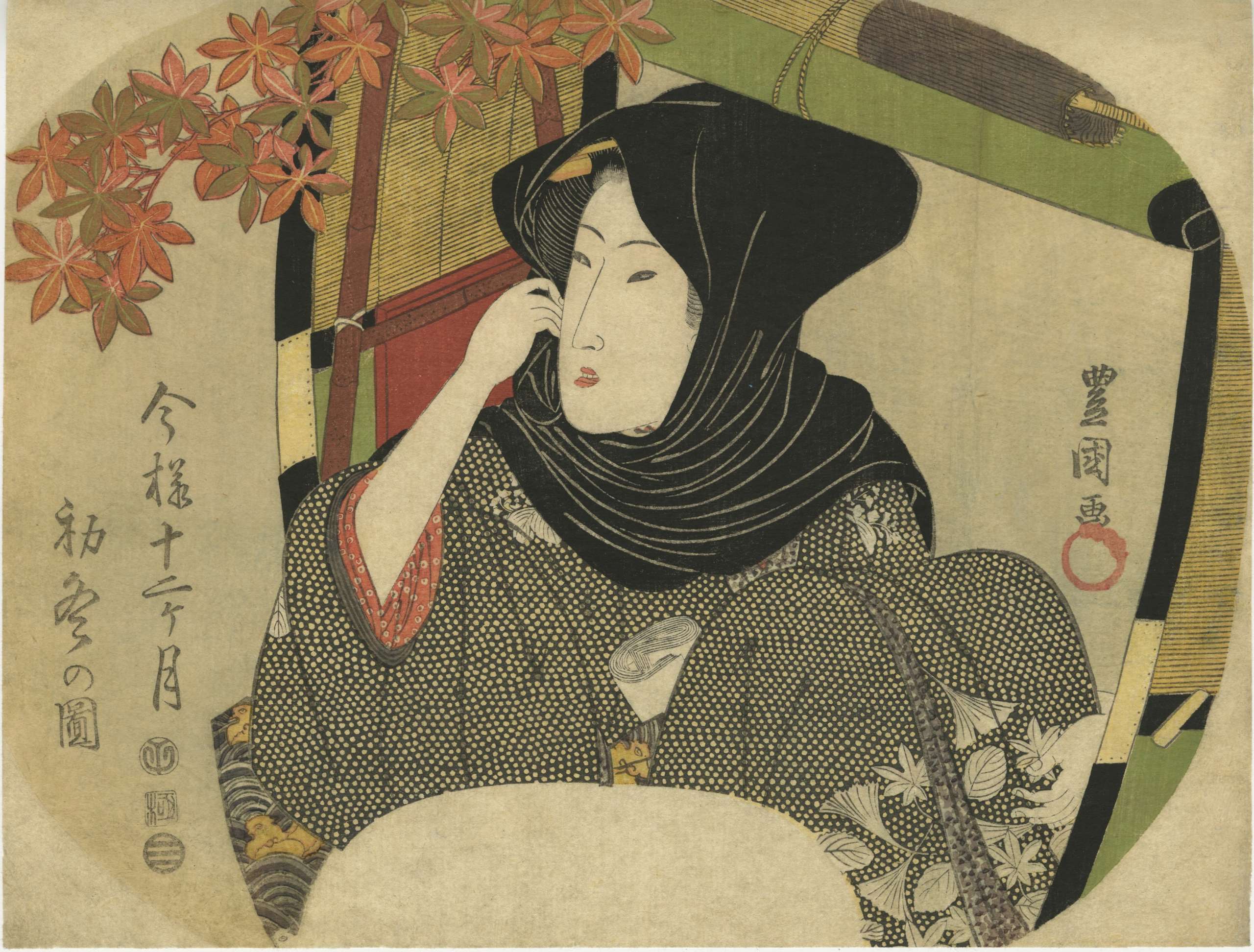

-
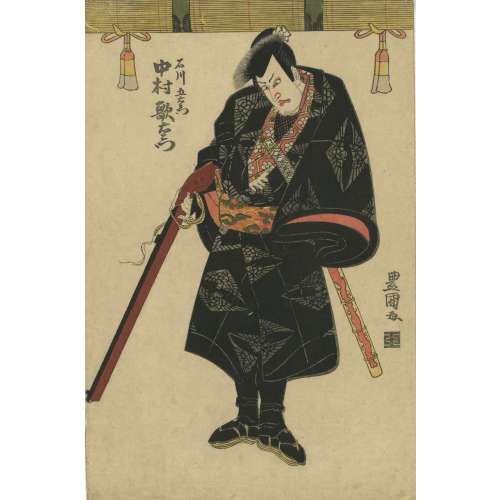 Utagawa Toyokuni (歌川豐國); 1769 – 24 February 1825. The actor Nakamura Utaemon as Ishikawa Goemon. Circa 1810. Size/Format: Oban, 9.75 by 14.5 inches
Utagawa Toyokuni (歌川豐國); 1769 – 24 February 1825. The actor Nakamura Utaemon as Ishikawa Goemon. Circa 1810. Size/Format: Oban, 9.75 by 14.5 inches -
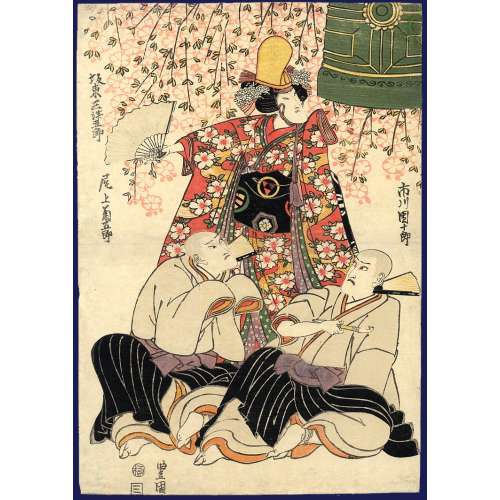 Artist: Utagawa Toyokuni I (1769–1825) Title: Actors Bando Mitsugorō, Ichikawa Danjūrō, Onoe Kikugorō in play The Maiden at Dōjō Temple. Presumably Bunka 13 (1816) at Nakamura Theater in Edo. Publisher: Mikawaya Seiemon (c. 1805-1829); Marks' "Publishers" № 328, p. 235. Size: Vertical ôban MEDIUM OR TECHNIQUE: Woodblock print (nishiki-e); ink and color on paper. Signed: Toyokuni ga Censor's seal: kiwame Detailed discussion on the topic can be seen at: The Maiden at Dōjō Temple
Artist: Utagawa Toyokuni I (1769–1825) Title: Actors Bando Mitsugorō, Ichikawa Danjūrō, Onoe Kikugorō in play The Maiden at Dōjō Temple. Presumably Bunka 13 (1816) at Nakamura Theater in Edo. Publisher: Mikawaya Seiemon (c. 1805-1829); Marks' "Publishers" № 328, p. 235. Size: Vertical ôban MEDIUM OR TECHNIQUE: Woodblock print (nishiki-e); ink and color on paper. Signed: Toyokuni ga Censor's seal: kiwame Detailed discussion on the topic can be seen at: The Maiden at Dōjō Temple -
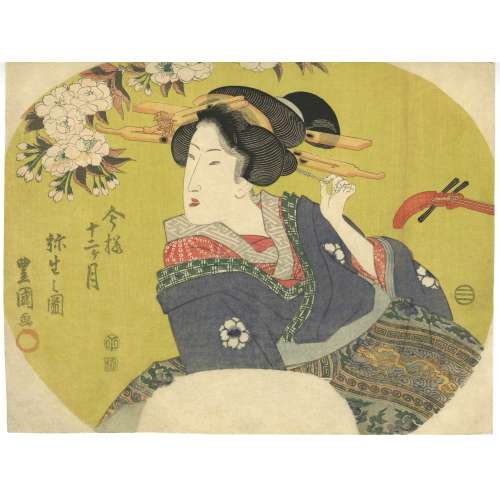 Title: Third lunar month [弥生] (Yayoi no zu); Series: Fashionable Twelve Months (Imayo juni-kagetsu). Another version of translation: Modern Beauties of Twelve Months. Artist: Utagawa Toyokuni I [歌川豊国] (1769–1825). Pubisher: Ibaya Senzaburō [伊場屋仙三郎] (Japanese, 1815 – 1869), seal: Dansendō [伊場仙]. Signed: Toyokuni ga and sealed with toshidama. Date-kiwame seal: Ushi (ox), Bunsei 5 (1822). Size: double-sheet uncut fan print ( aiban uchiwa-e), 219 x 295 mm.
Title: Third lunar month [弥生] (Yayoi no zu); Series: Fashionable Twelve Months (Imayo juni-kagetsu). Another version of translation: Modern Beauties of Twelve Months. Artist: Utagawa Toyokuni I [歌川豊国] (1769–1825). Pubisher: Ibaya Senzaburō [伊場屋仙三郎] (Japanese, 1815 – 1869), seal: Dansendō [伊場仙]. Signed: Toyokuni ga and sealed with toshidama. Date-kiwame seal: Ushi (ox), Bunsei 5 (1822). Size: double-sheet uncut fan print ( aiban uchiwa-e), 219 x 295 mm.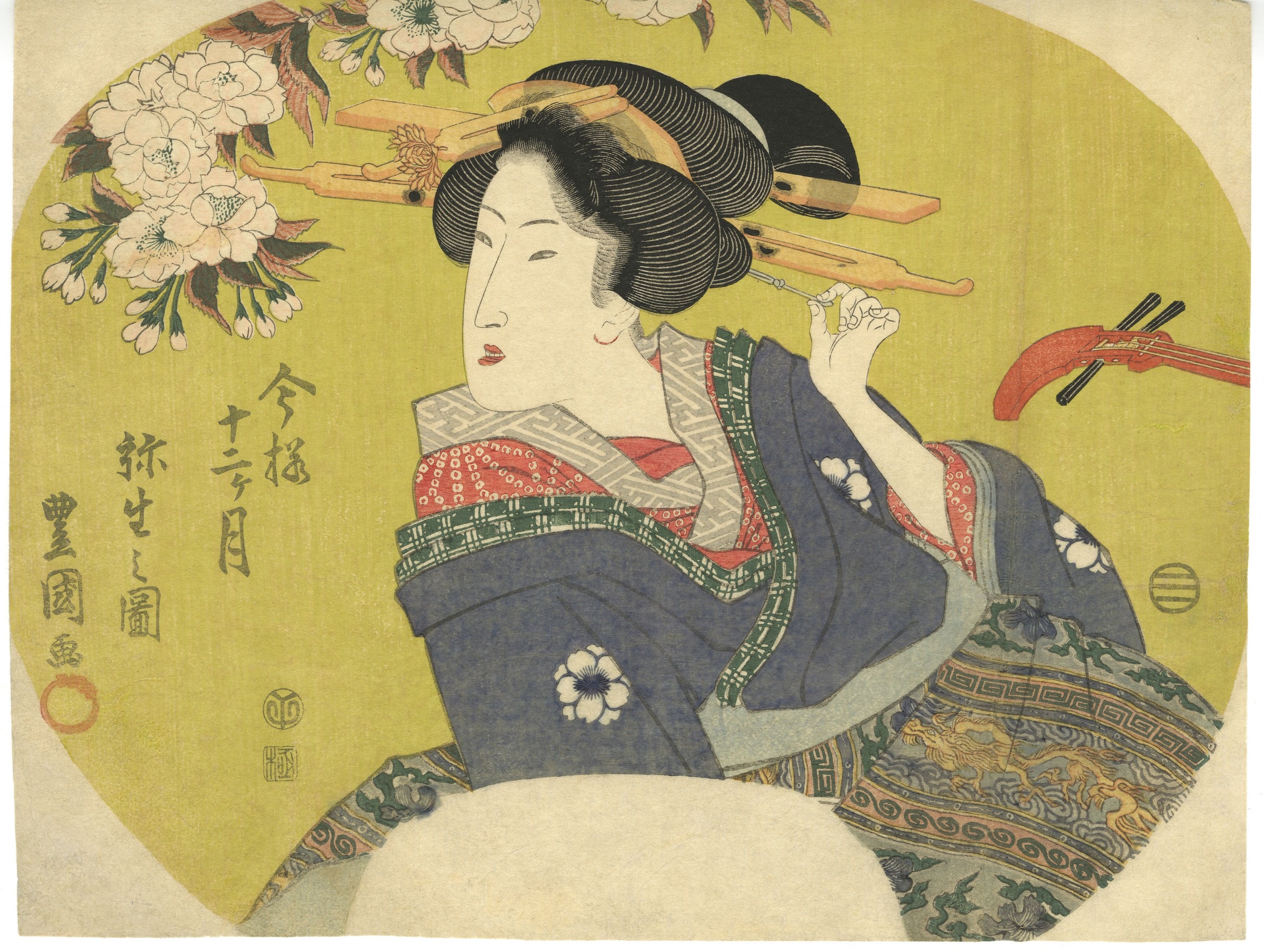
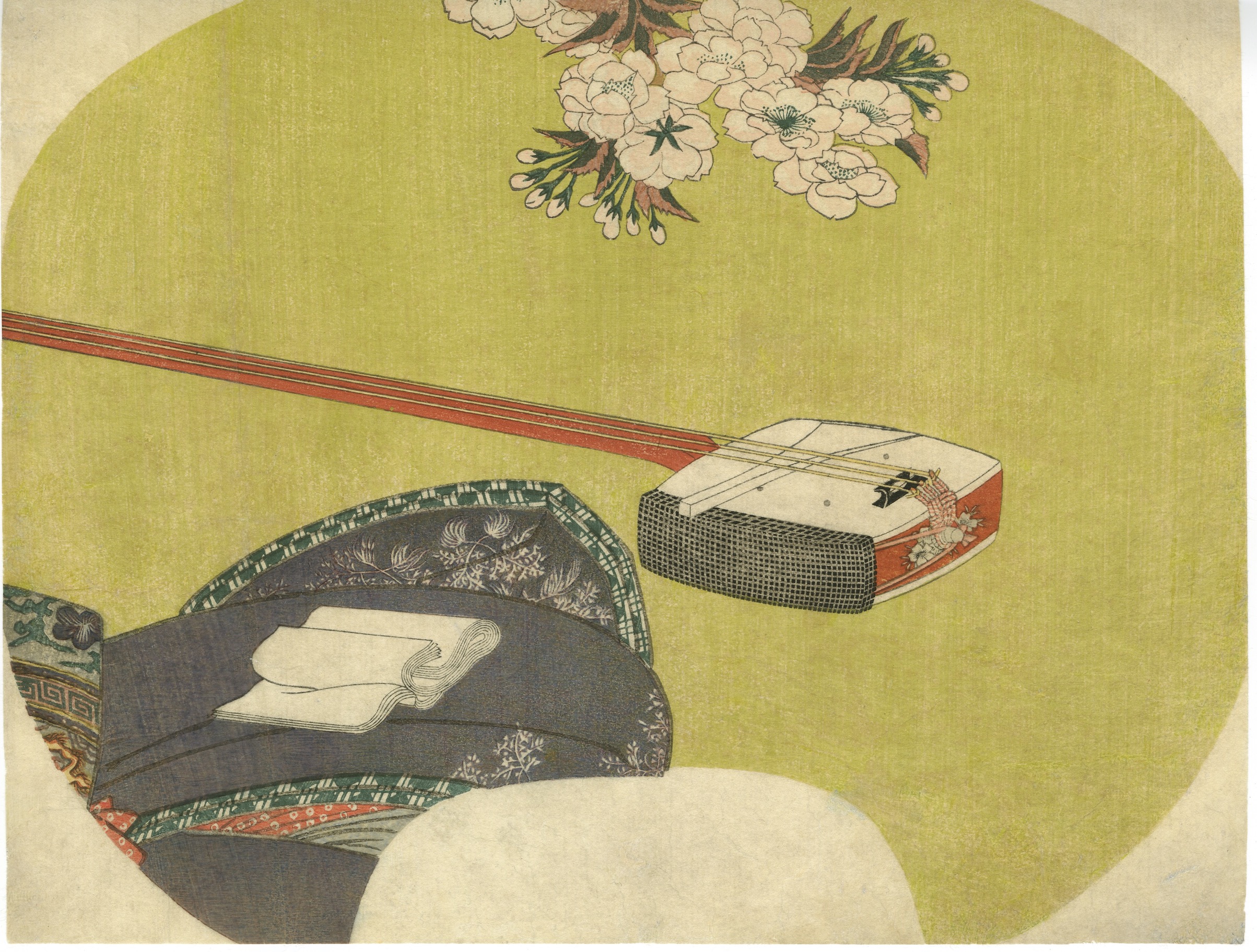
-
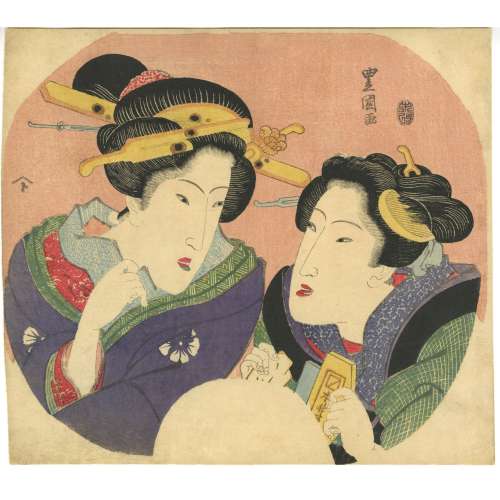 Artist: Utagawa Toyokuni I [歌川豊国] (1769–1825). Pubisher: Enshūya Matabei (遠州屋又兵衛) (c. 1768 – 1881), seal name: Enmata [ 遠又]. Signed: Toyokuni ga [豊国画]. Date-aratame censor seal: 未改, Bunsei 6 (1823). Size: uchiwa-e; 233 x 262 mm. Ref: Israel Goldman. Japanese Prints, Paintings and Books / Catalogue 28, 2022: № 14.
Artist: Utagawa Toyokuni I [歌川豊国] (1769–1825). Pubisher: Enshūya Matabei (遠州屋又兵衛) (c. 1768 – 1881), seal name: Enmata [ 遠又]. Signed: Toyokuni ga [豊国画]. Date-aratame censor seal: 未改, Bunsei 6 (1823). Size: uchiwa-e; 233 x 262 mm. Ref: Israel Goldman. Japanese Prints, Paintings and Books / Catalogue 28, 2022: № 14. -
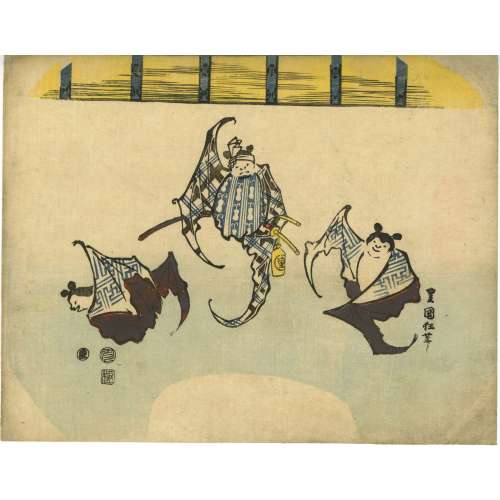 NEWArtist: Utagawa Toyokuni II [歌川豊国二代] a.k.a. Toyoshige [豊重] (Japanese, (1777 – 1835) Signed: 豊国狂筆 (Toyokuni kyō-hitsu, "mad brush of Toyokuni") Publisher: Maru-Jū (丸重), seal Jū (重), Marks reference 08-079 | U190a (1826–1829, only on fan prints) Censor Seal: Kiwame + Bunsei 12 (Year of the Ox [丑], 1829) Media: Uchiwa-e (fan print), color woodblock print, 230 × 293 mm
NEWArtist: Utagawa Toyokuni II [歌川豊国二代] a.k.a. Toyoshige [豊重] (Japanese, (1777 – 1835) Signed: 豊国狂筆 (Toyokuni kyō-hitsu, "mad brush of Toyokuni") Publisher: Maru-Jū (丸重), seal Jū (重), Marks reference 08-079 | U190a (1826–1829, only on fan prints) Censor Seal: Kiwame + Bunsei 12 (Year of the Ox [丑], 1829) Media: Uchiwa-e (fan print), color woodblock print, 230 × 293 mmA fantastical kabuki-themed scene depicting three anthropomorphic bats, dressed in Edo-period costumes. The central figure, likely Ichikawa Danjūrō VII (市川團十郎七, 1791–1859), is distinguished by his costume featuring a gourd motif (瓢箪, hyōtan)—a symbol closely linked to the Ichikawa family. He wears two swords, further identifying him as a kabuki hero, and carries a sake flask marked with what appears to be the publisher's emblem. His raised arm (or wing?) suggests a dramatic action, possibly striking or threatening the bat figure on the left, who recoils in response.
The two side bats, also dressed in patterned kimono, display expressions contrasting with the central figure—one appearing startled, while the other remains cheerful. The oxidized lead-orange pigment used in the lower portions of their wings suggests depth and texture.
This print reflects Danjūrō VII’s association with both the bat (蝙蝠, kōmori) and the double gourd. Bats were considered lucky symbols due to their resemblance to the character of "good fortune" (福, fuku), and Danjūrō VII often incorporated bat motifs into his stage costumes. The Ichikawa family's crest, the mimasu (三升, "three squares"), was more commonly used, but the double gourd and bat imagery appeared in promotional materials, reinforcing his theatrical identity. -
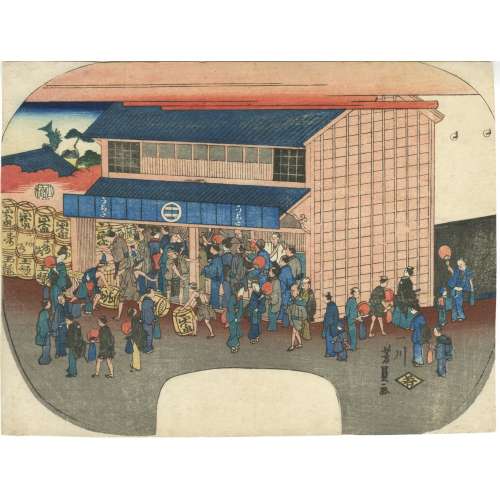 Artist: Utagawa Yoshikazu [歌川芳員] (Japanese, fl. c. 1850 – 1870). Publisher: Wakasaya Yoichi [若狭屋与市] (Japanese, fl. 1794 – 1897). Combined date seal and kiwame censor seal: 1861 (Man'en 2 / Bunkyū 1, from 19/02).
Artist: Utagawa Yoshikazu [歌川芳員] (Japanese, fl. c. 1850 – 1870). Publisher: Wakasaya Yoichi [若狭屋与市] (Japanese, fl. 1794 – 1897). Combined date seal and kiwame censor seal: 1861 (Man'en 2 / Bunkyū 1, from 19/02). -
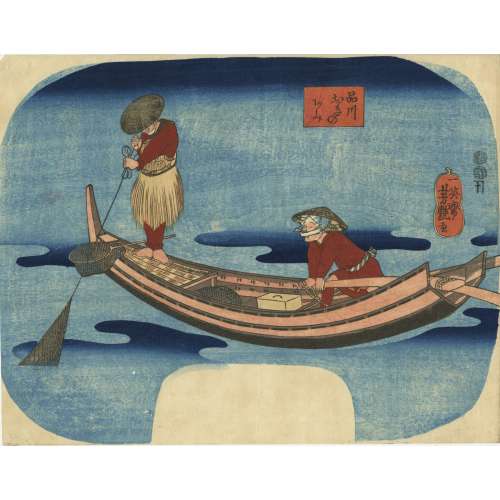 Artist: Utagawa Yoshitsuya [歌川 芳艶] (Japanese, 1822 – 1866). Publisher: Kojimaya Jūbei [小島屋重兵衛] (Japanese, c. 1797 – 1869). Date seal and double nanushi censor seals: Kunigasa & Yoshimura, Kōka 5 (1849). Signed: Ichieisai Yoshitsuya ga [英斎芳艶画] in a red double gourd cartouche. Two men are fishing with a net off the coast of Shinagawa, in the Edo Bay.
Artist: Utagawa Yoshitsuya [歌川 芳艶] (Japanese, 1822 – 1866). Publisher: Kojimaya Jūbei [小島屋重兵衛] (Japanese, c. 1797 – 1869). Date seal and double nanushi censor seals: Kunigasa & Yoshimura, Kōka 5 (1849). Signed: Ichieisai Yoshitsuya ga [英斎芳艶画] in a red double gourd cartouche. Two men are fishing with a net off the coast of Shinagawa, in the Edo Bay. -
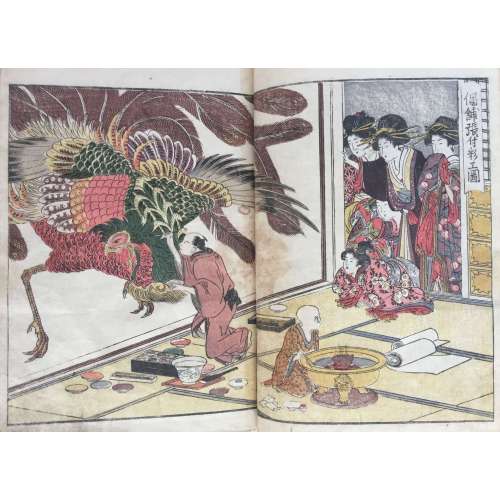 Seiro ehon nenju gyoji 青楼絵本年中行事 (A Picture Book of Annual Events in Yoshiwara). Block cut by: Fuji Kazumune (藤一宗). Printed by: Jakushodo Toemon (霍松堂藤右衛門). Written by: Jippensha Ikku (十返舎一九) (text, kyoka 4 & 12). Published by: Kazusaya Chusuke (上総屋忠助). Print artist: Kitagawa Utamaro (喜多川歌麿). Written by: Sandara Boshi (三陀羅法師) (kyoka 1). Workshop of: Yashiki no Katamaru (屋職堅丸). 1804 (spring); Edo. Reference: British Museum; Fine Arts Museums of San Francisco.
Seiro ehon nenju gyoji 青楼絵本年中行事 (A Picture Book of Annual Events in Yoshiwara). Block cut by: Fuji Kazumune (藤一宗). Printed by: Jakushodo Toemon (霍松堂藤右衛門). Written by: Jippensha Ikku (十返舎一九) (text, kyoka 4 & 12). Published by: Kazusaya Chusuke (上総屋忠助). Print artist: Kitagawa Utamaro (喜多川歌麿). Written by: Sandara Boshi (三陀羅法師) (kyoka 1). Workshop of: Yashiki no Katamaru (屋職堅丸). 1804 (spring); Edo. Reference: British Museum; Fine Arts Museums of San Francisco. -
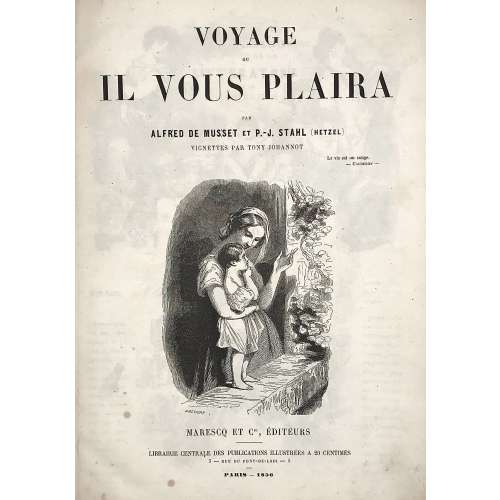
Voyage ou Il vous plaira by Alfred de Musset and P.-J. Stahl (Hetzel); Tony Johannot (illustrations). [Les chefs d'oeuvres de la litterature et de l'illustration] // Marescq et Cie, éditeurs, - Paris, 1856.
Contes de Charles Nodier by Jean Charles Emmanuel Nodier (1780 – 1844) illustrated by H. Émy.
Owner's binding in red half Morocco, A4 (297 x 219 mm). "Voyage ou Il vous plaira" (60 pages) and fairy tales by Charles Nodier with illustrations by H. Émy (Armand-Louis-Henri Telory, born in Strasbourg in 1820 and died in 1874): "La Fée aux miettes" ; "Le songe d'or (fable levantine)"; "La légende de la Soeur Béatrix"; "Trilby"; Inès de las Sierras"; "Baptiste Montauban"; "Smarra ou les démons de la nuit"; "La neuvaine de la Chandeleur"; "La combe de l’homme mort". Extensive foxing, owner's pencil drawings on some pages, otherwise good condition.
-
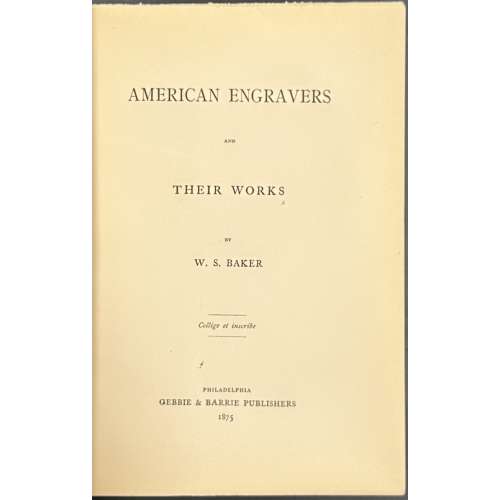 Hardcover, 19 x 13.8 cm, crimson buckram with tan paper label with lettering to spine; printed on laid paper; pp.: ffl [i-vi] vii-x] 11-184, collation 8vo, 1-118 124, total 92 leaves. Title-page: AMERICAN ENGRAVERS | AND | THEIR WORKS | BY | W. S. BAKER | Collige et inscribe | PHILADELPHIA | GEBBIE & BARRIE PUBLISHERS | 1875 || Motto: Collige et inscribe [Collect and record, lat.] Contributors: William Spohn Baker (American, 1824 – 1897) – author. George Gebbie (American, 1832 – 1892) – publisher. George Barrie (American, 1843 – 1918) – publisher. George R. Bonfield (British-American, 1802 – 1898) – dedicatee.
Hardcover, 19 x 13.8 cm, crimson buckram with tan paper label with lettering to spine; printed on laid paper; pp.: ffl [i-vi] vii-x] 11-184, collation 8vo, 1-118 124, total 92 leaves. Title-page: AMERICAN ENGRAVERS | AND | THEIR WORKS | BY | W. S. BAKER | Collige et inscribe | PHILADELPHIA | GEBBIE & BARRIE PUBLISHERS | 1875 || Motto: Collige et inscribe [Collect and record, lat.] Contributors: William Spohn Baker (American, 1824 – 1897) – author. George Gebbie (American, 1832 – 1892) – publisher. George Barrie (American, 1843 – 1918) – publisher. George R. Bonfield (British-American, 1802 – 1898) – dedicatee. -
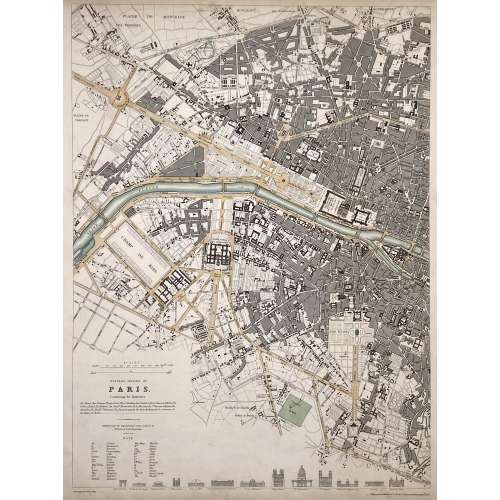 WESTERN DIVISION OF | PARIS. | Containing the Quartiers | {4 lines in italic} | Published under the Superintendence of the Society for the | Diffusion of Useful Knowledge || Under the frame: Drawn by W. B. Clarke, Archt. […] Published by Baldwin & Cradock, 47 Paternoster Row, April 1st. 1834. Dimensions: Sheet: 40.5 x 34.5 cm; Image: 39 x 28.8 cm. Contributors: William Barnard Clarke (British, 1806 – 1865) – artist. John Shury (fl. c. 1814-1844) – engraver. Baldwin & Cradock (London) – publisher. Society for the Diffusion of Useful Knowledge (SDUK) (British firm, 1826 – 1846).
WESTERN DIVISION OF | PARIS. | Containing the Quartiers | {4 lines in italic} | Published under the Superintendence of the Society for the | Diffusion of Useful Knowledge || Under the frame: Drawn by W. B. Clarke, Archt. […] Published by Baldwin & Cradock, 47 Paternoster Row, April 1st. 1834. Dimensions: Sheet: 40.5 x 34.5 cm; Image: 39 x 28.8 cm. Contributors: William Barnard Clarke (British, 1806 – 1865) – artist. John Shury (fl. c. 1814-1844) – engraver. Baldwin & Cradock (London) – publisher. Society for the Diffusion of Useful Knowledge (SDUK) (British firm, 1826 – 1846). -
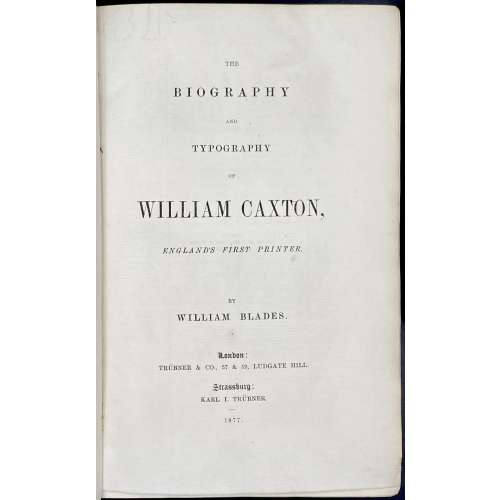 Title: THE | BIOGRAPHY AND | TYPOGRAPHY | OF | WILLIAM CAXTON, | ENGLAND'S FIRST PRINTER. | BY | WILLIAM BLADES. | LONDON : | TRÜBNER & CO, 57 & 59 LUDGATE HILL. | STRASSBURG : | KARL I. TRÜBNER. | 1877. || Pagination: ffl, [2] blank, [i, ii] - t.p., imprint, [iii], iv, v - preface, [vi] - cul-de-lampe, [vii], viii - contents; [1], 2-383 [384] - imprint, 2] - blanks, bfl.; 18 plates: op. p. 8, 22, 54 (3), 60, 126 (4), 283, [311], 336, 358 (5). Collation: 8vo; [A]4 B-Z8 AA8 BB7. Exterior: 22.6 x 14.8 cm, printed on watermarked Zanders laid paper, original brown decorated paper boards, spine with decoration and lettering, marbled end-papers, water stain to bottom of upper cover, slightly rubbed, upper margin marbled, other untrimmed, binder's mark to back pastedown: "Bound by Simpson & Renshaw". Bookplates to front pastedown: upper: F. Marcham | Tempora mutantur, nos et mutamur in illis. | Hornsey | 1907"; lower: (2) "From the library of | H. Harvey Frost". Caxton, William (British, c. 1422 – 1491). Blades, William (British, 1824-1890) Frank Marcham (1883 – 1934), motto: "Times are changed, we also are changed with them". This book is based on the author's The Life and Typography of William Caxton, London: J. Lilly, 1861-63, – "A new 'Life' in a more handy form".
Title: THE | BIOGRAPHY AND | TYPOGRAPHY | OF | WILLIAM CAXTON, | ENGLAND'S FIRST PRINTER. | BY | WILLIAM BLADES. | LONDON : | TRÜBNER & CO, 57 & 59 LUDGATE HILL. | STRASSBURG : | KARL I. TRÜBNER. | 1877. || Pagination: ffl, [2] blank, [i, ii] - t.p., imprint, [iii], iv, v - preface, [vi] - cul-de-lampe, [vii], viii - contents; [1], 2-383 [384] - imprint, 2] - blanks, bfl.; 18 plates: op. p. 8, 22, 54 (3), 60, 126 (4), 283, [311], 336, 358 (5). Collation: 8vo; [A]4 B-Z8 AA8 BB7. Exterior: 22.6 x 14.8 cm, printed on watermarked Zanders laid paper, original brown decorated paper boards, spine with decoration and lettering, marbled end-papers, water stain to bottom of upper cover, slightly rubbed, upper margin marbled, other untrimmed, binder's mark to back pastedown: "Bound by Simpson & Renshaw". Bookplates to front pastedown: upper: F. Marcham | Tempora mutantur, nos et mutamur in illis. | Hornsey | 1907"; lower: (2) "From the library of | H. Harvey Frost". Caxton, William (British, c. 1422 – 1491). Blades, William (British, 1824-1890) Frank Marcham (1883 – 1934), motto: "Times are changed, we also are changed with them". This book is based on the author's The Life and Typography of William Caxton, London: J. Lilly, 1861-63, – "A new 'Life' in a more handy form". -
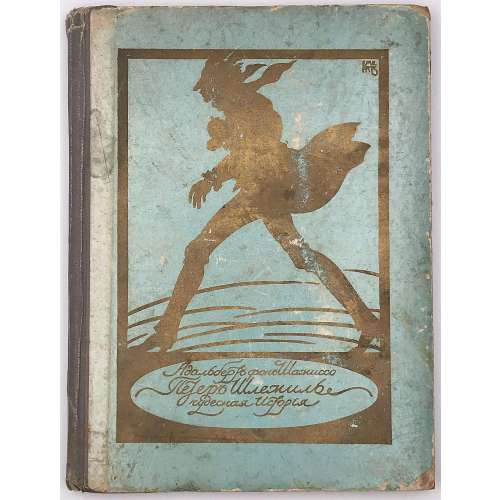
Шамиссо, Адальбертъ фонъ. Петеръ Шлемиль. Чудесная исторiя. Пер. П.Потемкина. Рис., виньетки и перепет Эмиля Преторiуса по 1-му нѣм. изд. 1814 г. — СПб.: Книгоиздательство "Пантеонъ", 1910. — 107 стр. Отпечатано в типографии акц. о-ва типографск. дела в СПБ (Герольд), 7 рота, 26.
Cardboard binding, 8vo, 20 x 15 cm. Russian translation of Adelbert von Chamisso book Peter Schlemihl, from the German by Peter Potemkine. With illustrations from 1814 original German first edition by Emil Preetorius. [SV: the latest statement seems strange as Emil Preetorius lived from 1883 to 1973]. -
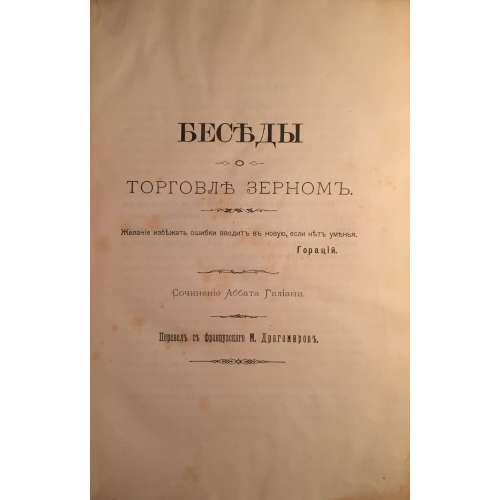
Беседы о торговле зерном. Сочинение аббата Галиани. Перевел с французского М. Драгомиров. — [Киев]: [тип. Окр. Штаба], [1891]. — [4], III, [3], 210, XXII стр. Примечание: Доб. тит. л. на фр. яз.: Dialogues sur le commerce des bleds. — A Londres, MDCCLXX.
-
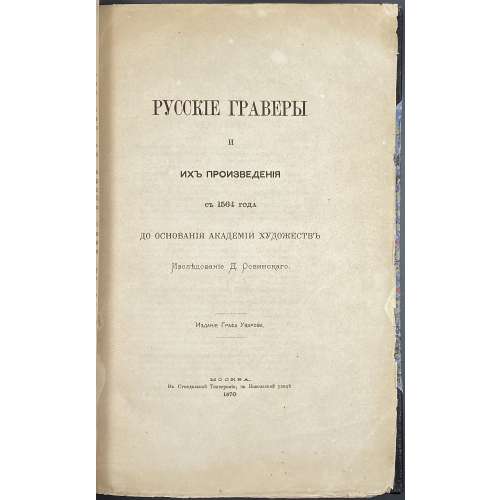 Title: РУССКIЕ ГРАВЕРЫ | И | ИХЪ ПРОИЗВЕДЕНIЯ | СЪ 1564 ГОДА | ДО ОСНОВАНIЯ АКАДЕМIИ ХУДОЖЕСТВЪ. | Изследованiе Д. Ровинскаго. | Изданiе графа Уварова. | МОСКВА. | Въ Сѵнодальной типографiи, на Никольской улицѣ. | 1870. || Pagination: [2] orig. wrapper / advert., [2] t.p. / imp.[i] ii-x, [1] 2-403 [404], [2] orig. wrapper / advert. Collation: 8vo; π6 (incl. t.p.), 1-258 χ2 Binding: Owner’s ½ black morocco over marbled boards, raised bands, gilt-ruled, florets and lettering in compartments, blue endpapers, uncut, untrimmed, original wrappers preserved. Size: 29.5 x 19 cm
Title: РУССКIЕ ГРАВЕРЫ | И | ИХЪ ПРОИЗВЕДЕНIЯ | СЪ 1564 ГОДА | ДО ОСНОВАНIЯ АКАДЕМIИ ХУДОЖЕСТВЪ. | Изследованiе Д. Ровинскаго. | Изданiе графа Уварова. | МОСКВА. | Въ Сѵнодальной типографiи, на Никольской улицѣ. | 1870. || Pagination: [2] orig. wrapper / advert., [2] t.p. / imp.[i] ii-x, [1] 2-403 [404], [2] orig. wrapper / advert. Collation: 8vo; π6 (incl. t.p.), 1-258 χ2 Binding: Owner’s ½ black morocco over marbled boards, raised bands, gilt-ruled, florets and lettering in compartments, blue endpapers, uncut, untrimmed, original wrappers preserved. Size: 29.5 x 19 cm -
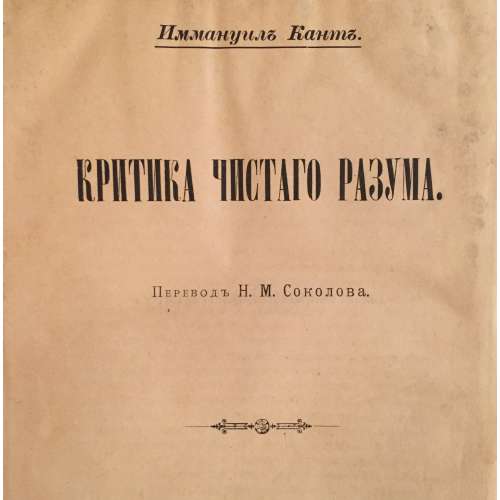 Иммануил Кант. Критика чистого разума. Пер. Н. М. Соколова. С.-Петербург. Издание книжного магазина М. В. Попова, 1897. - 674 с.
Иммануил Кант. Критика чистого разума. Пер. Н. М. Соколова. С.-Петербург. Издание книжного магазина М. В. Попова, 1897. - 674 с. -

Конфуциева летопись. Чунь-Цю. (Весна и осень) Перевод Н. Монастырева. (С литографированными примечаниями). С.-Петербург, Тип. бр. Пантелеевых, 1876. 107 с. Тир. 600 экз.
Примечания отсутствуют. Не разрезана.
-
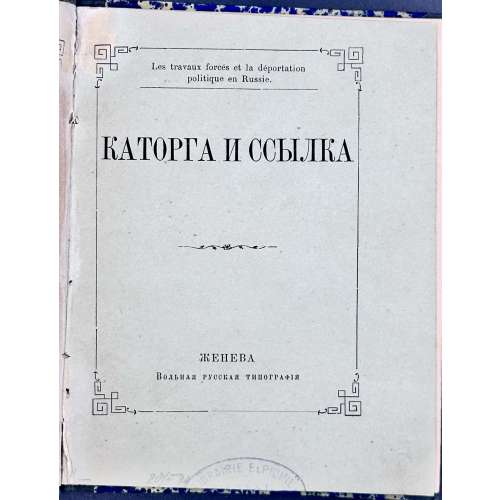 Owner’s half-cloth over marbled boards, 150 x 117 mm, convolute of two clandestine publications, approx. 1890, original light blue wrappers preserved; title pages in frame with meander corners: (1) Les travaux forcés et la déportation | politique en Russie. | КАТОРГА И ССЫЛКА | ~ | ЖЕНЕВА | Вольная русская типографiя || pp.: 1-67 [68 blank], black ink stamp — М. Цебрикова to p. 67. (2) Lettre à l'Empereur Alexandre III. | ПИСЬМО | ИМПЕРАТОРУ АЛЕКСАНДРУ III | ~ | ЖЕНЕВА | Вольная русская типографiя || pp.: 1-40, black ink stamp М. Цебрикова to p. 40. Цебрикова, Мария Константиновна (Russian, 1835 – 1917)
Owner’s half-cloth over marbled boards, 150 x 117 mm, convolute of two clandestine publications, approx. 1890, original light blue wrappers preserved; title pages in frame with meander corners: (1) Les travaux forcés et la déportation | politique en Russie. | КАТОРГА И ССЫЛКА | ~ | ЖЕНЕВА | Вольная русская типографiя || pp.: 1-67 [68 blank], black ink stamp — М. Цебрикова to p. 67. (2) Lettre à l'Empereur Alexandre III. | ПИСЬМО | ИМПЕРАТОРУ АЛЕКСАНДРУ III | ~ | ЖЕНЕВА | Вольная русская типографiя || pp.: 1-40, black ink stamp М. Цебрикова to p. 40. Цебрикова, Мария Константиновна (Russian, 1835 – 1917) -

Макиавелли Николай. Государь (Il Principe) и Рассуждения на первые три книги Тита Ливия. Пер. c итал. Н. Курочкина. Издание "Русской книжной торговли". - СПб.; тип. Тиблена и Ко. (Неклюдова), 1869. - 502 стр.
-

Поль Дельтуф. Жизнь и творения Макиавелли. // "Записки для чтения, издаваемые К. Трубниковым", 1867, NN 8-9, с. 73-77. Ежемесячное приложение к Биржевым ведомостям. Август и Сентябрь. Санктпетербург. Тип. Товарищества "Общественная польза".
"Essai sur les oeuvres et la doctrine de Machiavel, avec la traduction littérale du Prince et de quelques fragments historiques et littéraires", par Paul Deltuf, Paris, 1867.
-
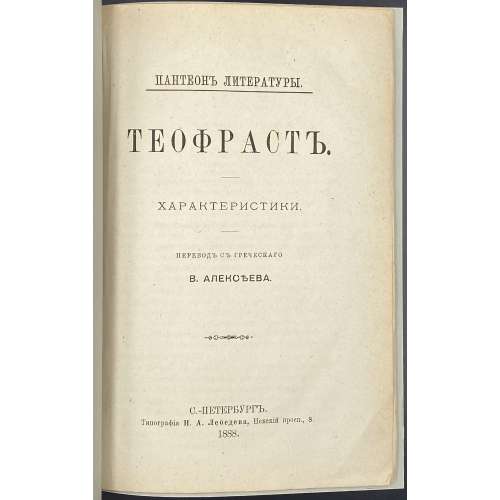 Title page: ПАНТЕОНЪ ЛИТЕРАТУРЫ | ТЕОФРАСТЪ. | ХАРАКТЕРИСТИКИ. | ПЕРЕВОДЪ СЪ ГРЕЧЕСКАГО | В. АЛЕКСѢЕВА. |—| С.–ПЕТЕРБУРГЪ. | Типографiя Н. А. Лебедева, Невскiй просп., 8. | 1888. || Pagination: [1-3] 4-32; 32 pages. Collation: 8vo; 1-28; 16 leaves. Binding: Modern owner’s grey wrappers, blank. Page size: 23.2 x 16 cm Contributors: Theophrastus [Θεόφραστος, Theόphrastos, Теофраст, Феофраст] (Greek, c. 371 – c. 287 BC) – author. Алексеев, Василий Алексеевич (Russian, 1863 – 1919) – translator. Лебедев, Николай Афанасьевич (Russian, 1813 – 1896); Типография Н. А. Лебедева (СПб) – publisher, printer.
Title page: ПАНТЕОНЪ ЛИТЕРАТУРЫ | ТЕОФРАСТЪ. | ХАРАКТЕРИСТИКИ. | ПЕРЕВОДЪ СЪ ГРЕЧЕСКАГО | В. АЛЕКСѢЕВА. |—| С.–ПЕТЕРБУРГЪ. | Типографiя Н. А. Лебедева, Невскiй просп., 8. | 1888. || Pagination: [1-3] 4-32; 32 pages. Collation: 8vo; 1-28; 16 leaves. Binding: Modern owner’s grey wrappers, blank. Page size: 23.2 x 16 cm Contributors: Theophrastus [Θεόφραστος, Theόphrastos, Теофраст, Феофраст] (Greek, c. 371 – c. 287 BC) – author. Алексеев, Василий Алексеевич (Russian, 1863 – 1919) – translator. Лебедев, Николай Афанасьевич (Russian, 1813 – 1896); Типография Н. А. Лебедева (СПб) – publisher, printer. -

Жуковский Ю. Г. Политические и общественные теории XVI-го века. - С.Петербург, 1866. Типография А. Головачева. // Материалы для общественной науки. - 163 с.
Схоластика.
Макиавелли и Томас Мор.
Реформация: Лютер, Кальвин, анабаптисты.
Жан Боден.
[Штамп на титуле: A. Namoradze, Tiflis. 1935.]



